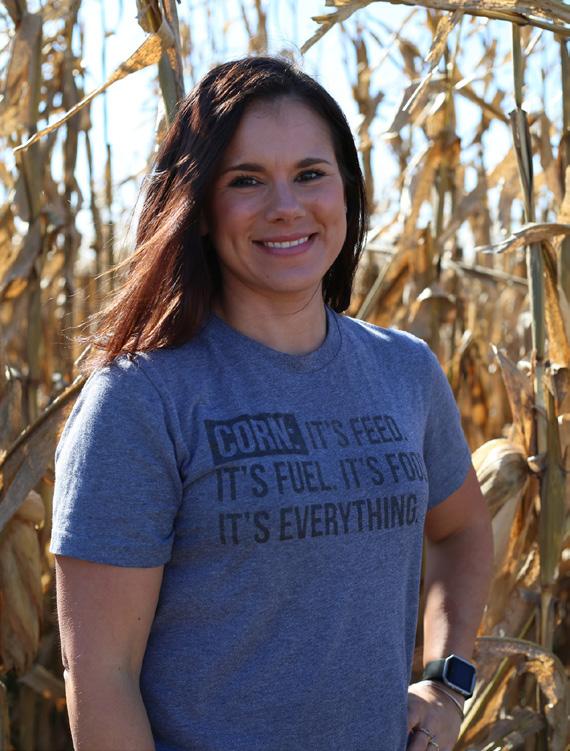

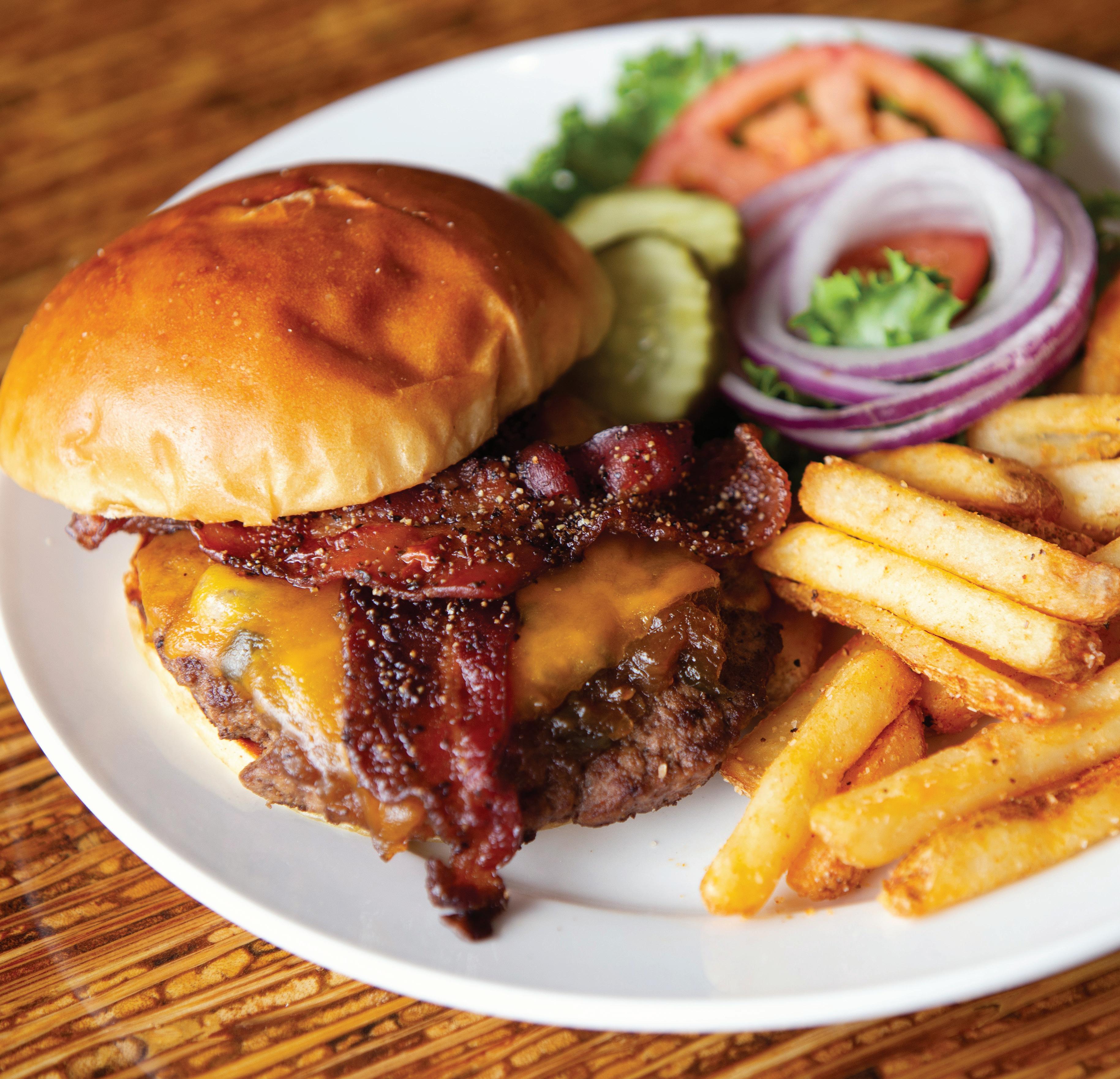

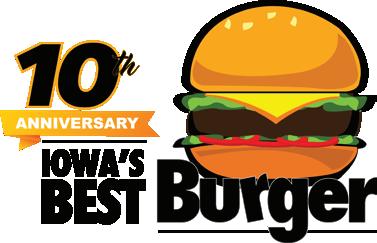








IN THE SUMMER ISSUE OF FRESH PICKINGS MAGAZINE, YOU’LL FIND STORIES THAT CELEBRATE THE INCREDIBLE FOOD, FARMS AND FAMILIES THAT MAKE IOWA A SPECIAL PLACE TO LIVE.
THIS QUARTERLY PUBLICATION IS COURTESY OF THE IOWA FOOD & FAMILY PROJECT — AN INITIATIVE INVITING IOWANS TO EXPLORE HOW FOOD IS GROWN AND RAISED AROUND THE STATE AND MEET THE FARMERS WHO MAKE IT HAPPEN; 24/7, 365 DAYS A YEAR.
WE NETWORK WITH NEARLY 35 FOOD, FARMING AND HEALTHY LIVING ORGANIZATIONS WHO ARE PROUD OF IOWA’S HOMEGROWN FOODS AND HOMETOWN VALUES. YOU CAN LEARN MORE ABOUT OUR PARTNERS ON PAGE 4.


12
CELEBRATING THE AG IN RAGBRAI
Learn how the iconic annual bike ride immerses cyclists from around the globe on a journey through Iowa farm country.
16
BEEF FROM PASTURE TO PLATE
Steak fresh off the grill is the perfect centerpiece of an All-American summertime meal.
22 FARMING SMARTER
From soil samples to aerial imaging, data points come together to give farmers powerful precision in the field.
28
PIZZA TOPPED WITH RUSTIC CHARM
On a country road in southeast Iowa, a farm turns into a rustic outdoor Friday night dining destination.

The “udderly” amazing eastern Iowa dairy balances a world-class trifecta of technology, sustainability and values. 38
A scoop of sweet corn ice cream with blackberry sauce is a delicious summertime treat. Find the recipe on Page 37.
MAGAZINE
EDITOR
KELLY VISSER
PHOTO EDITOR
JOSEPH L. MURPHY
CREATIVE
CATE NEWBERG
ASHTON BOLES
WRITERS
ANN CLINTON
LAUREN HOUSKA
AARON PUTZE, APR
ANN THELEN
Thelen Public Relations
CRISTEN CLARK
Food & Swine
HALEY BANWART
Farm Roots & Chore Boots
DARCY DOUGHERTY MAULSBY
Darcy Maulsby & Co.
FOUNDERS
Iowa Soybean Association
Iowa Pork Producers Association
Iowa Beef Industry Council
Midwest Dairy
Iowa Corn Growers Association
Iowa Poultry Association
Iowa Egg Council
Iowa Turkey Federation
The Soyfoods Council
SUPPORTERS
Anderson Erickson Dairy
Cookies Food Products
Corteva Agriscience
BROUGHT TO YOU BY THE IOWA FOOD & FAMILY PROJECT Fresh
Earl May Nursery & Garden Center
Farm Credit Services of America
Heart of America Group
Hy-Vee
Iowa Grocery Industry Association
Iowa Machine Shed Restaurant
Iowa Select Farms
Iowa State Fair
Jethro’s BBQ
Key Cooperative
Latham Hi-Tech Seeds
Live Healthy Iowa
MercyOne Subway
REQUEST YOUR MAILED SUBSCRIPTION AT IOWAFOODANDFAMILY.COM/MAGAZINE/SUBSCRIBE
Thank you to the Iowa Soybean Association, Iowa Pork Producers Association, Iowa Beef Industry Council, Midwest Dairy, Iowa Corn Growers Association, Iowa Egg Council, Farm Credit Services of America, Corteva Agriscience, Iowa Select Farms, Key Cooperative and Latham Hi-Tech Seeds for the financial investment that makes this publication possible.
For advertising information, please contact kvisser@iasoybeans.com. Advertising space reservations must be made through the above contact information. In consideration of the acceptance of the advertisement, the agency and advertiser must, in respect of the contents of the advertisement, indemnify and save the publisher harmless against any expense arising from claims or actions against the publisher because of the publication of the content of the advertisement. Comments: iowafoodandfamily.com/magazine/feedback

The first bite of fresh sweet corn stirs up simple yet treasured family memories.
For me, sweet corn is a memory of my grandpa buzzing from roadside stand to roadside stand, making fast friends with the growers and sellers at each stop.
It’s sitting barefoot on the deck stairs, assigned by my mom to shuck the latest dozen, hands sticky after patiently picking out the lingering bits of silk on each ear.
It’s my family’s ongoing debate on the correct way to eat sweet corn – my mom in rounds, my dad and I in rows – all scoffing at my sister’s choice to slice the kernels off the ear.
And it’s the satisfaction of finding the perfect combination of creamy flavor and indescribable “pop” of juiciness.
If you’re an Iowan, I’m guessing you also have treasured sweet corn memories. Like most food, sweet corn is universal. It’s timeless. It’s a simple pleasure that unites us.
In this issue of Fresh Pickings , we spotlight some of the summertime traditions Iowans share – firing up the grill, savoring a scoop of dairy-fresh ice cream or cheering on a favorite baseball team – and the aspects of agriculture that make each moment possible.
The stories in this issue serve up nostalgia for summers past, but more importantly, inspire you to see the season from a new perspective.
This magazine is also an open invitation to be a part of the Iowa Food & Family Project's farm-to-table conversations. Join in by meeting the people who produce your favorite foods, ask questions about agriculture and share what you learn with those you love.
Enjoy the issue and the sweet corn,


Cristen Clark is a pig farmer, creator of the Food & Swine blog and award-winning baker and cook. She lives on a farm near Runnells with her husband Mike and children Halle and Barrett.
Grilling is a glorious way to cook during the hot, steamy summer months in Iowa. Heading outside feels like a special cooking occasion that gives me the excuse to take in the scenery and cool down the kitchen.
At our house, a classic Iowa Porterhouse pork chop on the grill simply can’t be beat. But throughout the summer, I like to mix up my grilling fare. One of my favorite ways to add variety is with kabobs. They’re popular in our house because they are make-ahead friendly and can include many of the fresh veggies and proteins raised right here in Iowa.
Inspired by the flavors of a comforting pesto pasta dish my kids adore, I developed a simple recipe for Pesto Pork & Veggie Kabobs. It’s satisfying and fuels everyone for summer days and evenings of baseball, farm pond swimming and 4-H chores.
The simple seasoning and final brushing of basil pesto makes a fresh, delicious dinner option the entire family will enjoy.
While the concept of kabobs is simple, it can get a little tricky to cook to perfection. Some of my favorite kabob tips and tricks are quick and easy.
Use disposable skewers. My favorite type of disposable skewer is made of bamboo. The trick is to soak them in water for 30 minutes before threading the ingredients to prevent the skewers from burning or breaking during grilling.
Par-cook and pair ingredients. If you’re using ingredients with highly differing cook times, try parcooking (partially cooking) slower cooking ingredients like corn on the cob or raw chunks of potato. You can also thread individual skewers with the same ingredients so they will all cook perfectly together and can be removed at the proper time.
Try zone grilling. I always use twozone grilling with direct (burners on) and indirect (burners off) heat to prevent the tips of vegetables or fruits from becoming too charred. It works great to place the kabobs over direct heat for initial grilling, and then allow them to finish cooking over indirect heat.
Many recipes encourage the use of leftover marinade for basting at the end of grilling. This can create some food safety concerns if you’re using marinade that originally covered raw meat. Instead, set aside a portion of the marinade mix at the beginning and use it to cover the meat.
3-4 pounds boneless pork loin, cut into 2-inch cubes
16 ounces cremini or white button mushrooms, washed and dried
1 large red onion, quartered
2 bell peppers (yellow and red), cut into 1½-inch square pieces
2 small zucchinis, cut into ½-inch coins
1½ teaspoons seasoned salt
½ teaspoon ground black pepper
½ cup Italian dressing
1/3 cup basil pesto
12 large skewers
Preheat grill to medium-high heat.
Thread 12 wooden or metal skewers with pork loin, mushrooms, red onion pieces, bell pepper pieces and zucchini coins (if using wooden skewers, soak in water for 30 minutes prior to threading with ingredients). Sprinkle evenly with seasoned salt and black pepper.
Brush on Italian dressing. Grill over medium-high heat, 4-5 minutes on one side, then flip and grill for an additional 4-5 minutes. To test kabobs for doneness, use a digital instant read thermometer to check the thickest part of the pork without touching the skewer. Once the pork has reached 145 degrees F, remove kabobs from heat and rest for 3 minutes. Brush with basil pesto and serve warm.
243 calor ies, 7.8 carbohydrates, 13 g fat, 1.1g saturated fat, 31g protein, 0.7g fiber, 31g sodium

















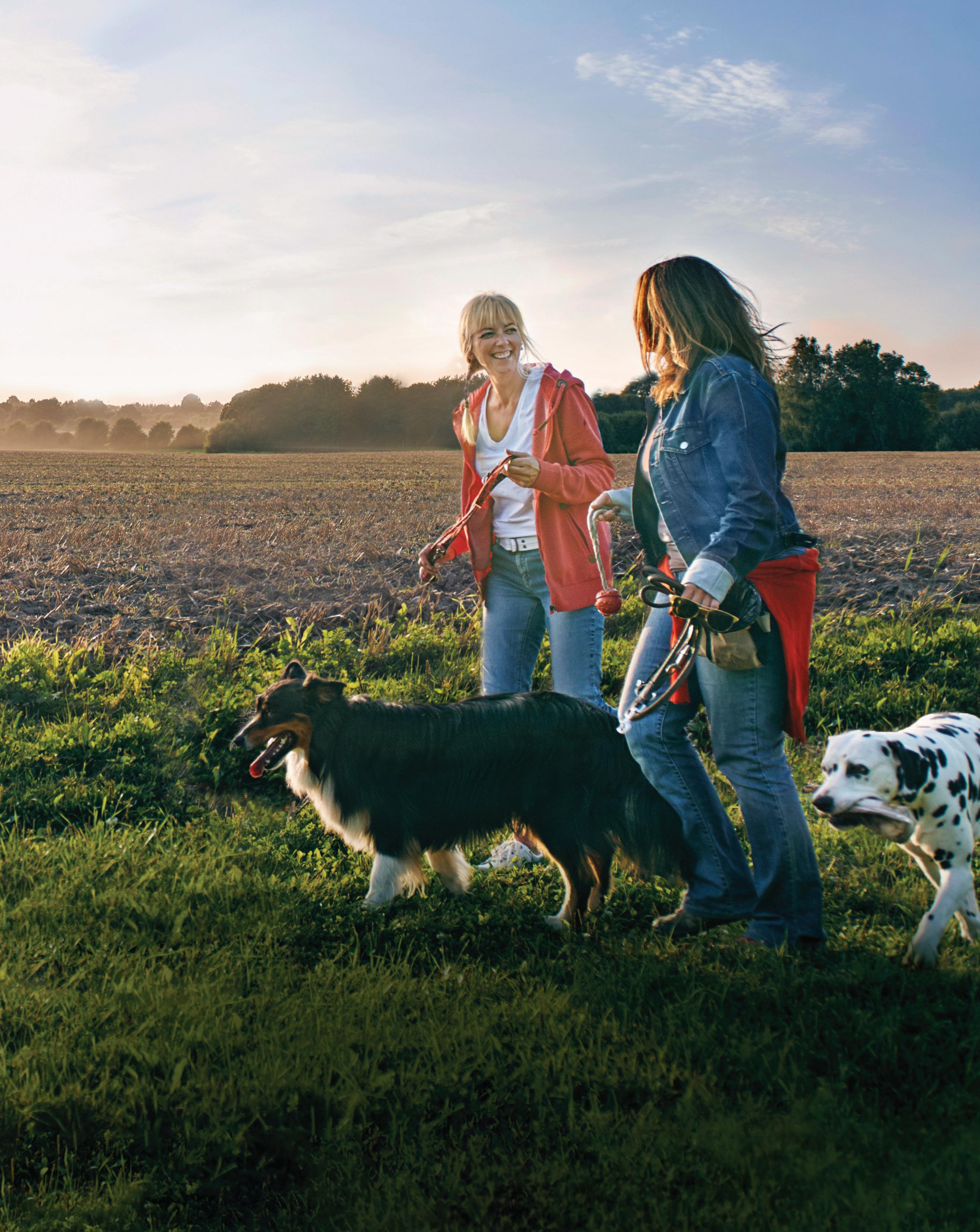


Iowans have a powerful new support circle. MercyOne now has more highly-rated specialty services than any network in Iowa. And more than 20,000 health-focused team members with one mission—to help you live your best life.








LIVE HEALTHY IOWA'S 5 EASY TIPS FOR PUMPING UP THE H 2 O
By Ann ThelenWhen Iowa’s temperatures and heat indices rise, a refreshing glass of water can be your best friend. One of the best ways to combat the summer warmth and avoid heat-related illnesses is to stay hydrated. The team at Live Healthy Iowa shares five easy tips for pumping up your water intake all summer long.
1. WAKE UP TO WATER
A good night’s sleep is essential for repairing your body each day, but it can also leave you dehydrated. Before reaching for a cup of java in the morning, drink 16 ounces of water. Not only does it rehydrate your body, but it also releases toxins and improves digestion.
Fill large bottles with how much water you should drink each day. Not only does it make it easy to reach for water, but it’s also a great way to monitor intake throughout the day. If you’re not sure how much water you need to drink, a popular rule is to divide your weight by 50% and drink that many ounces of water each day. The amount can vary based on weight, age, exercise and other factors.
3. EAT YOUR WATER
Cucumbers and lettuce are made up of a whopping 96% water. Be creative in adding these types of foods to your mealtime routine. Munch on cucumbers for a snack or ditch the bread and wrap your sandwich in lettuce. Other nutritious fruits, such as watermelon and strawberries, are 92% water but also higher in carbohydrates.
4. INFUSE WITH COLOR
It’s easy to get bored with water – so boost its flavor with colorful herbs, fruits and veggies! Try adding slices of lemons, limes, cucumbers, pineapple or cantaloupe and pair them with mint, basil or other herbs. Unlike juice, the flavor is refreshing and has fewer calories.
5. THINK THIRST FIRST
Since your body contains up to 65% water, sunshine and heat can quickly lead to dehydration. Know the signs, symptoms and treatments for dehydration. Regardless of the season, hunger is often an early sign of dehydration, so always drink water before eating.
The Iowa Food & Family Project is proud to be presenting sponsor of Live Healthy Iowa.
 By Haley Banwart / Photos by Joseph L. Murphy
By Haley Banwart / Photos by Joseph L. Murphy
From classic colas to root beer floats, small town Iowa is full of delightful flavors, novel experiences and friendly faces.
For decades, old-fashioned soda fountains were at the center of the small-town social scene. It was a place where friends and neighbors gathered to swap stories or indulge in a malt, milkshake or other sweet treat.
Famous for their long counters, iconic swivel stools, and an endless variety of flavored syrup and seltzer concoctions, many of these Prohibition-era establishments have faded into history. However, one soda fountain remains a thriving hub of main street activity in West Bend.
Originally named Vohs Drug Store by owner and pharmacist Gus Vohs, the shop opened for business along Broadway Avenue in 1928. His son Carl later expanded the shop to Vohs Sundry Store, selling diamonds, watches and fine jewelry in

addition to sodas, gifts, tonics and other remedies.
In 1963, the building was sold and renamed The Villager by Kent and Jane Eichelzer. The soda fountain transitioned ownership again in 1994 when Irv and Rita Beiter bought the store and started home delivery of prescriptions in the West Bend area from their pharmacy in Emmetsburg.
Today, The Villager is owned by Greg and Steve Hoyman of Hughes Health Mart in Emmetsburg and operates as a pharmacy, gift store, soda fountain, coffee house and flower shop.
It’s also a way of life for local patrons, like Phil Harris, who meet there every morning to enjoy good company and $1.25 bottomless cups of coffee.
“I’ve been going to The Villager for the better part of 30 years, but it has been a tradition in West Bend long before I was a regular,” he says. “It’s just a part of small-town living. Every day we visit and give each other a

hard time, we celebrate the good moments together and we grieve when there’s a loss.”
Considering soda fountains are no longer a dime a dozen, Harris says the continuation of a long-standing business like The Villager demonstrates the values Iowans share.
“It’s a sense of pride, and really a sense of community,” he says.
Mary Dawson, another West Bend resident and former employee at The Villager, agrees.
“No matter if you’re a regular or from out of town, the soda fountain is a friendly place where you can count on personal service and a fun atmosphere,” she says.
“We may be best known for the Grotto, but if you come uptown to the shop, you’ll see a reflection of the whole community.
“Plus, you won’t find a better malt anywhere,” she adds.
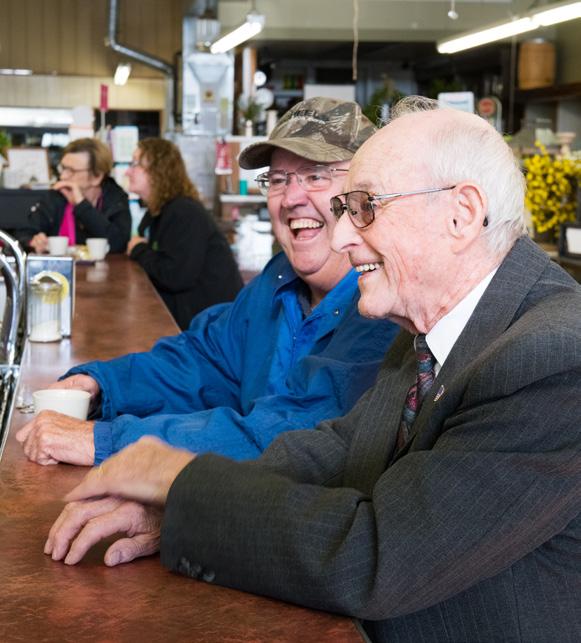


The Des Moines Register’s Annual Great Bicycle Ride Across Iowa (RAGBRAI®) began in 1973 when two reporters decided to cycle across the state and document their adventures for the newspaper. The duo publicized their route and invited readers to join their journey.
Since their initial trek, RAGBRAI has become the longest, largest and oldest bike touring event in the world.
“For 46 years, RAGBRAI has traveled the rural roads of Iowa stopping in the smallest communities with the biggest hearts,” says T.J. Juskiewicz, RAGBRAI director. “The towns
 By Ann Clinton
By Ann Clinton
refuel the riders with needed food, beverages and fun and the riders help give the local economies a boost.”
And between each stop, the richness of Iowa agriculture is in full view.
Juskiewicz adds, “After spending a week coasting by miles of soybean and corn fields, passing hundreds of farms with a variety of livestock that bridge the towns, it’s clear that Iowa is a leader in agriculture.”
In this case, seeing is truly believing. In the heat of the summer sun, Iowa’s fields and farms are vibrant. The state’s impressive agriculture —
consistently ranking top in the nation for producing pork, corn, eggs and soybeans — is on display.
“Riders, especially those who aren’t from the Midwest, are intrigued by our state,” says Brent Swart, a soybean and corn farmer from Spencer. “They are drawn to the open spaces and long, scenic roads. It’s refreshing to them.”
Drawing riders from all over the world, RAGBRAI has become an iconic celebration, allowing participants a unique opportunity to experience the beauty of Iowa’s landscape from two wheels.
FOR 46 YEARS, RAGBRAI HAS TRAVELED THE RURAL ROADS OF IOWA STOPPING IN THE SMALLEST COMMUNITIES WITH THE BIGGEST HEARTS.
- T.J. JUSKIEWICZ
Swart, who has ridden RAGBRAI for more than a decade, thinks the tradition is a perfect way to combine his love of cycling with his passion for agriculture. He travels with a core group of fellow bikers, and almost all in his group are either farmers or have a connection to agriculture.
“For me, RAGBRAI is all about the relationships I’ve developed over the years,” says Swart.
“We see the same people year after year, and we meet new friends along the way. Plus, the trip allows me to have conversations with folks about farming.”
According to Swart, many RAGBRAI participants are genuinely curious about the agriculture they see as they travel through the state. He says their questions are often very basic but provide a catalyst for more meaningful conversations.
“As farmers, we sometimes struggle with how to connect with consumers,” says Swart. “But for a week every year, those consumers come to us. It’s priceless. Not very often do we have an opportunity to talk to thousands of people who may not know very much about farming.”
However, Swart says he’s just one of many agricultural ambassadors engaging with RAGBRAI riders.

“Some farmers pull their combine and tractors out to display them for the cyclists,” he says. “There’s a lot of bonding happening as people love to share stories of the land. Many cyclists have a connection to the land, even if it’s through their ancestors.
“I hear a lot of people reference the kindness of Iowans,” continues Swart. “I guess it’s the ‘Iowa Nice’ perception. Being a part of an event like this reinforces the Midwestern values that I’ve always known to be true. It’s neat to see those sentiments echoed by people from around the globe.”
431,900
Source: 2017 Census of Agriculture, Coalition to Support Iowa’s Farmers and RAGBRAI.


RAGBRAI HAS COVERED 19,542 TOTAL MILES AND PASSED THROUGH 780 IOWA TOWNS SINCE

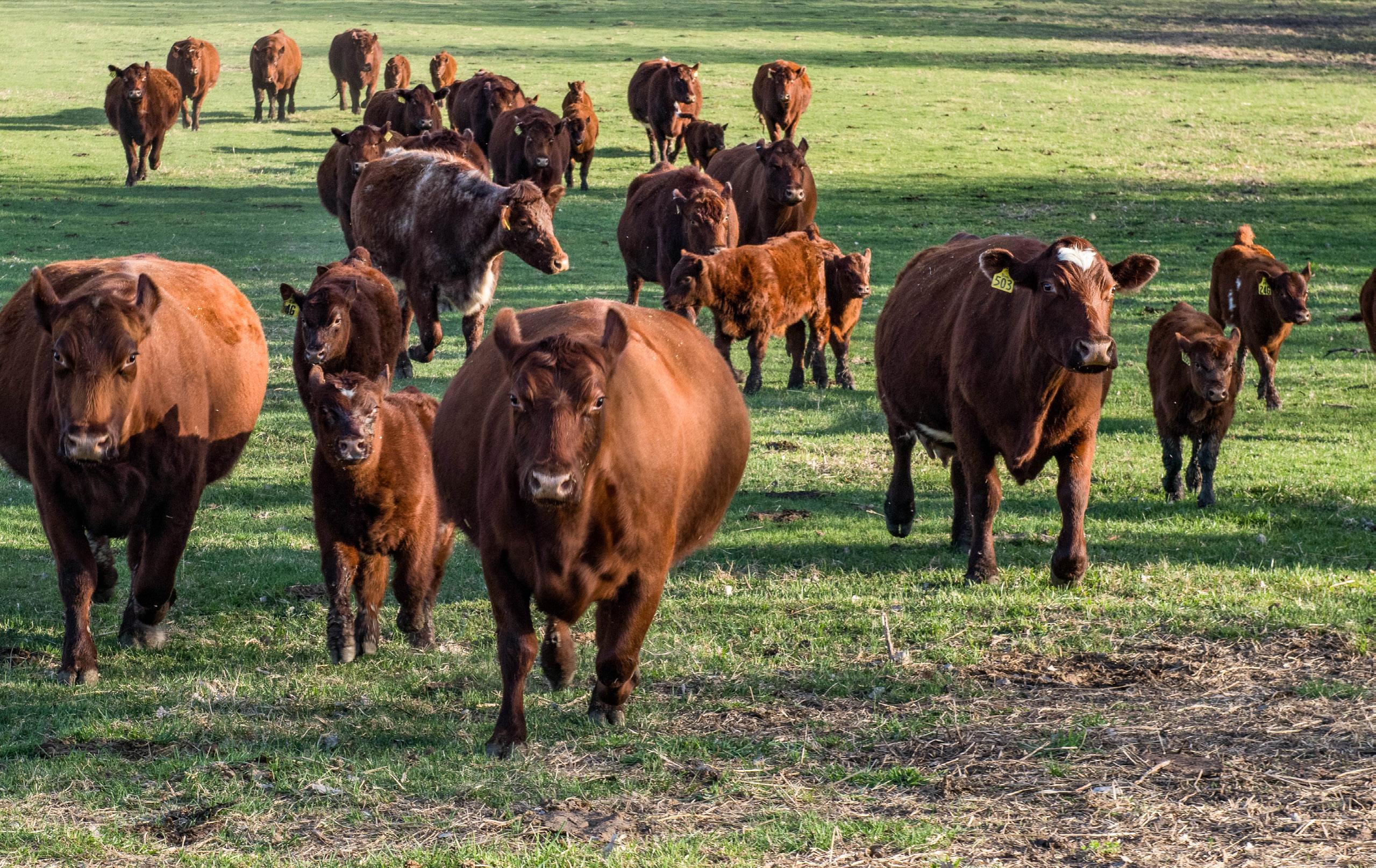
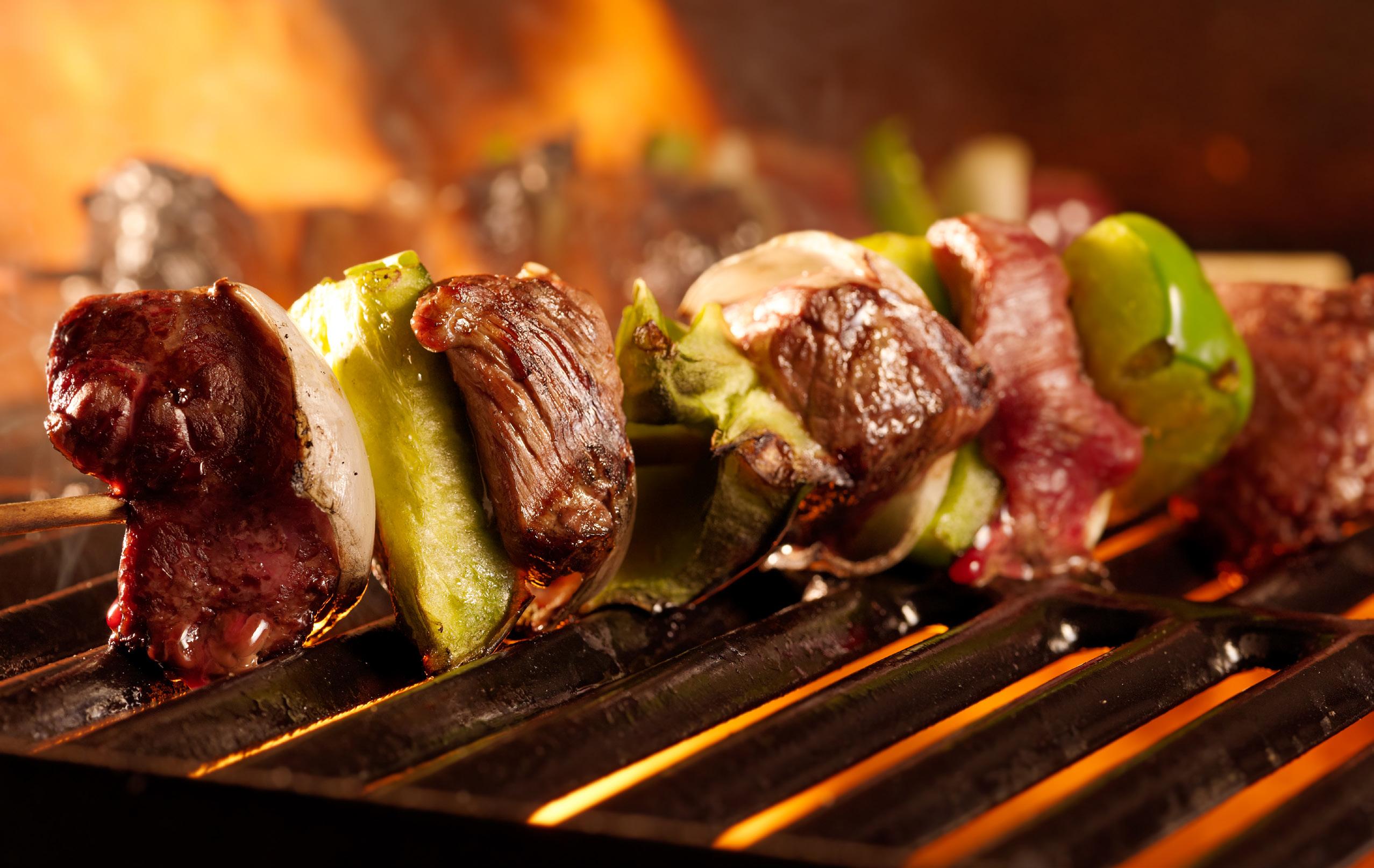
Good food brings people together. There’s nothing quite like having great conversations over a delicious meal. In the summer – when the days are long, and the sun and stars are bright – grilling is synonymous with warm weather. It creates a smoky richness in the air that is an AllAmerican aromatherapy.
There’s an unfettered joy that comes with tasting that first juicy burger of the season or hearing the searing and sizzling of flames
transforming a well-marbled ribeye steak into a mouthwatering delicacy. Beef is often on the list of go-to-favorites for grilling, and it’s likely an Iowa farmer had a hand in bringing the high-quality meat from a pasture to your plate.
For the Gilman family, who are cattle farmers in Adair County, their passion is for bringing good food (specifically beef) to consumers. They’re doing so in a remarkable way that blends several science facets – animal
science, food science and nutrition science – with consumer education and appreciation.
Cary and Rochelle Gilman feel fortunate to have raised their kids, Ethan and Leah, on the farm. “Having our kids involved in caring for the livestock has been one of the best teachers for life lessons they can have –responsibility, hard work, patience and perseverance,” Rochelle says. “We’re grateful they continue to be involved with the farm.”
The Gilmans are carrying on the tradition of raising cattle on land their ancestors began farming nearly 150 years ago, which is a definition of sustainability in itself. The father and son duo of Cary and Ethan are the fourth and fifth generations to farm the land, which is south of Stuart. Most of the cattle they raise are purebred Shorthorn cattle, which were introduced to the farm in the 1940s by Cary’s dad, Carl Gilman.
Cary and Ethan share the duties of the crop operation, which includes corn, soybeans and hay. Ethan — with the help of each family member — handles much of the daily cattle care, including nutrition and breeding decisions.
The farming roles don’t stop there, and it’s where the farm-to-consumer connection is strengthened.
Rochelle, Kathleen (Ethan’s wife) and Leah have full-time careers off the farm but still play vital roles in the farming operation.
On the farm, the trio handles social media, photography for the sale of Shorthorn cattle, website updates, daily chores during planting and harvest, monitoring the cattle during breeding and calving seasons, and regularly lends helping hands wherever needed.

graduated from Iowa State University (ISU) in December with a master’s degree in Food Science & Technology. She works as an assistant scientist at ISU where she specializes in the sensory evaluation of food products and ingredients.
was raised on a farm in Hardin County and graduated from ISU. She is a Registered Dietitian and serves as the Director of Nutrition & Health for the Iowa Beef Industry Council. She provides education and new beef nutrition research to health care professionals and consumers.
grew up on a ranch in western Nebraska and graduated from California Polytechnic State University with a bachelor’s degree in animal science with a concentration in beef production. After graduation, she worked for the American Shorthorn Association, where she met Ethan. She now works at automed in Huxley, a company providing cutting-edge hardware and software for livestock care.
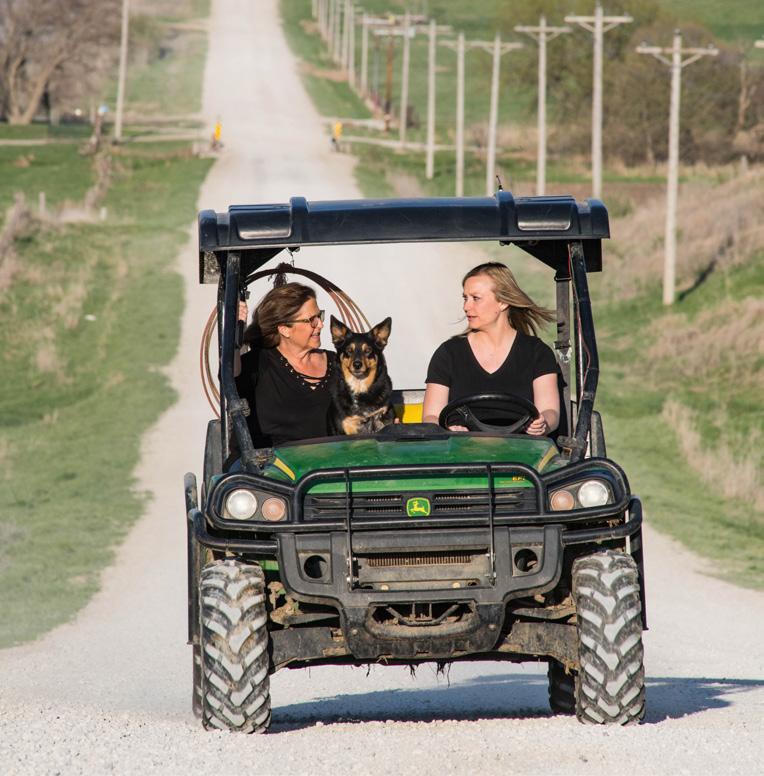
ROCHELLE, KATHLEEN AND LEAH SHARE ABOUT THE FAMILY’S FARMING OPERATION, WHAT MAKES BEEF PART OF A HEALTHY DIET, AND TIPS FOR SELECTING AND COOKING THE PERFECT CUT.
Leah: Consumer education is my passion. I was fortunate to grow up with a livestock producer for a dad and a dietitian for a mom. That truly is a pasture-toplate connection. I love helping consumers understand what we do as farmers and why we do it. On the flip side, I appreciate being able to share consumers’ concerns with producers like my family. Bridging the gap between the two is essential today.
Many people may not realize that farmers are scientists. My dad, brother and fiancé all have animal science degrees. They are constantly reading, researching and asking questions to learn new things. I want consumers to know that perspective. We have a lot in common — farmers are consumers, too.
Rochelle: Our most important job is taking care of the herd. We take pride in producing a highquality, wholesome and nutritious product. Cattle are checked daily for health and comfort and even more frequently, if needed, due to weather conditions or age. In the winter, we use corn stalks and straw for bedding to keep them warm and dry. Last winter, Cary and Ethan would often spend entire days making sure the cattle were on dry bedding and well fed. Mother Nature can be fierce, but we do as much as possible to prepare and be proactive so that our cattle stay healthy and protected.
Every day, the cattle are given clean water and feed. We use a computer program to track and monitor feed
rations so they receive all their nutritional needs, which can vary based on age, gestation, lactation, weather and other factors.
Kathleen: We work closely with the Stuart-Anita Veterinary Clinics for animal health needs. We rely heavily on ultrasound to know when calving will begin. That’s a key element of being prepared so that we know how many heifers and cows will be in the barn at any given time during the winter and spring calving season. When we’re not in the barns with the cattle, cameras in every barn allow us to monitor activities 24/7 via our cell phones and iPads.
Rochelle: We are Beef Quality Assurance (BQA) certified, which is a nationally coordinated, stateimplemented program to assist cattle operations in operating at the highest standards. It gives consumers trust and confidence in the beef they are purchasing and serving to their families.

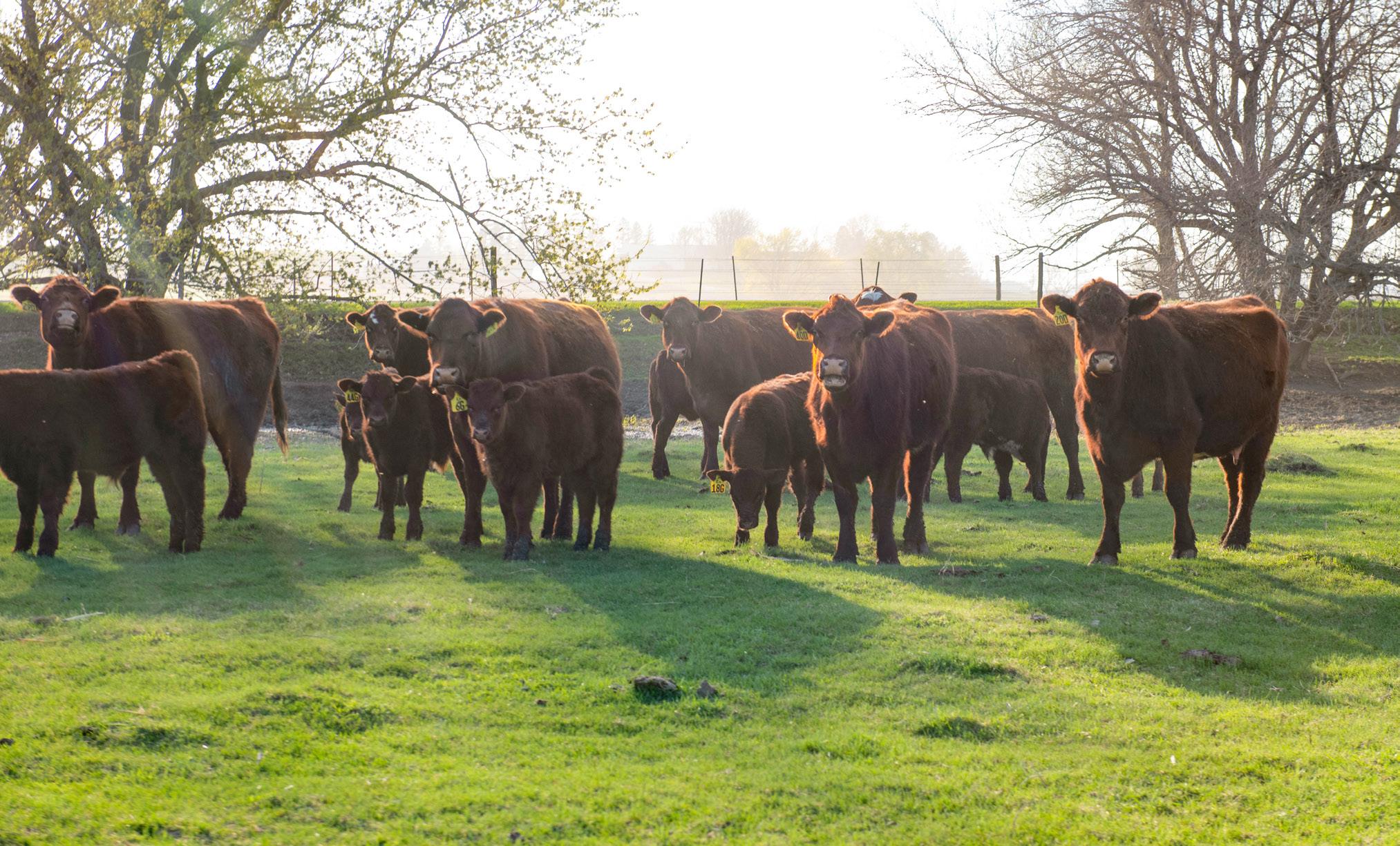
All: A ribeye steak cooked on the grill is hard to beat! When selecting a ribeye at the store, look for marbling – the white flecks of fat within the muscle cut. The more marbling, the juicier and more flavorful the steak will be. Shorthorn cattle are known for their wonderful marbling.
Leah: I also love a flank or strip steak because of its versatility.
Kathleen: In the winter, it’s hard to beat a beef roast. In the summer, we love to grill kabobs.
Rochelle: My recent favorite is a flat-iron steak, which is the second most tender cut of beef behind the tenderloin.
All: First, buy a high-quality cut of beef. Next, know the best way to cook the type of cut you have selected. A good resource is the “Beef. It’s What’s for Dinner” website (www.beefitswhatsfordinner.com)
the “Cuts” tab.
There are two types of marinades – one will tenderize the meat and the other is primarily for flavor – so use the type best suited for your beef cut.
Use a meat thermometer. For steak, remove from the heat source 5 to 10 degrees F before it reaches the desired doneness. Let it rest for 3-5 minutes to help the meat reabsorb the flavorful juices. Once cooked, cut against the grain for a more tender eating experience.
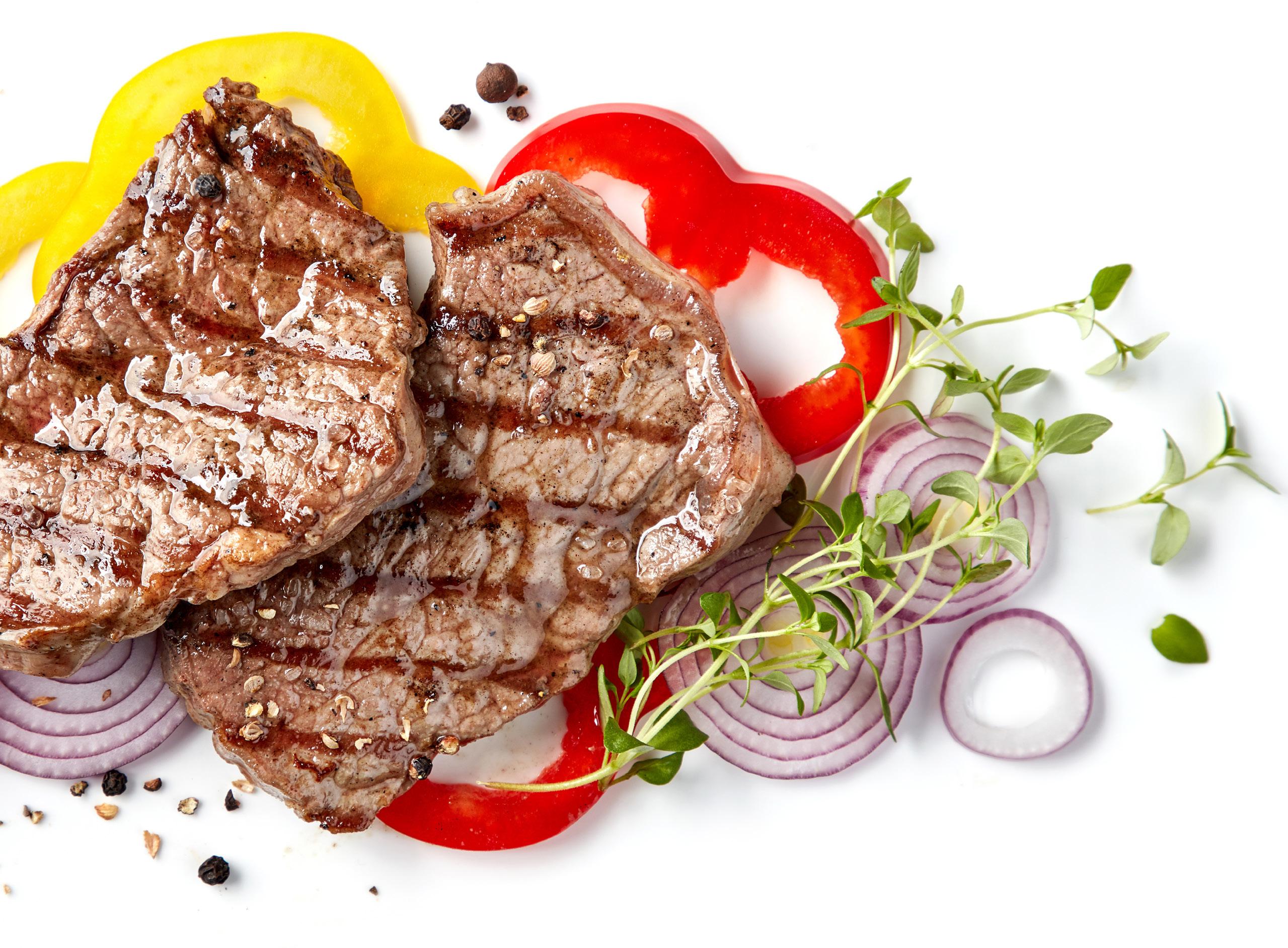
Beef is part of a satisfying heart-healthy lifestyle, and evidence shows lean beef in a heart-healthy diet can help support heart health. One 3-ounce serving of beef offers 25 grams of protein – about half the recommended total daily value – and 10 essential nutrients, including zinc, iron and B vitamins, which fuel a healthy lifestyle and help families thrive.
• Protein can help you stay full and satisfied longer, helping to maintain a healthy body weight.
• Animal proteins such as lean beef are complete, high-quality proteins that contain all the essential amino acids your body needs. Protein kick-starts muscle building in your body.
• You would have to eat 6.5 tablespoons of peanut butter (613 calories) to get the same amount of protein provided by one 3-ounce serving beef (173 calories).
Marinades are used to add flavor or tenderize. While the two different types of marinades may contain similar ingredients, the key is the length of marinating time. To add flavor, marinating for 15 minutes to 2 hours is adequate. To tenderize cuts, marinate for 6 to 24 hours.
• Always marinate in the refrigerator, never at room temperature.
• Allow ¼ to ½ cup of marinade for every pound of beef.
• Marinate in a food-safe plastic bag or in a non-reactive container, such as glass or plastic. Turn or stir the beef occasionally to allow even exposure to the marinade.
• Before cooking, remove beef from marinade and pat dry with a paper towel to promote even browning and prevent steaming.
• If a marinade is to be used for basting or as a sauce, reserve a portion of it before adding to the beef.
Source: Beef. It’s What’s for Dinner. and Iowa Beef Industry Council.
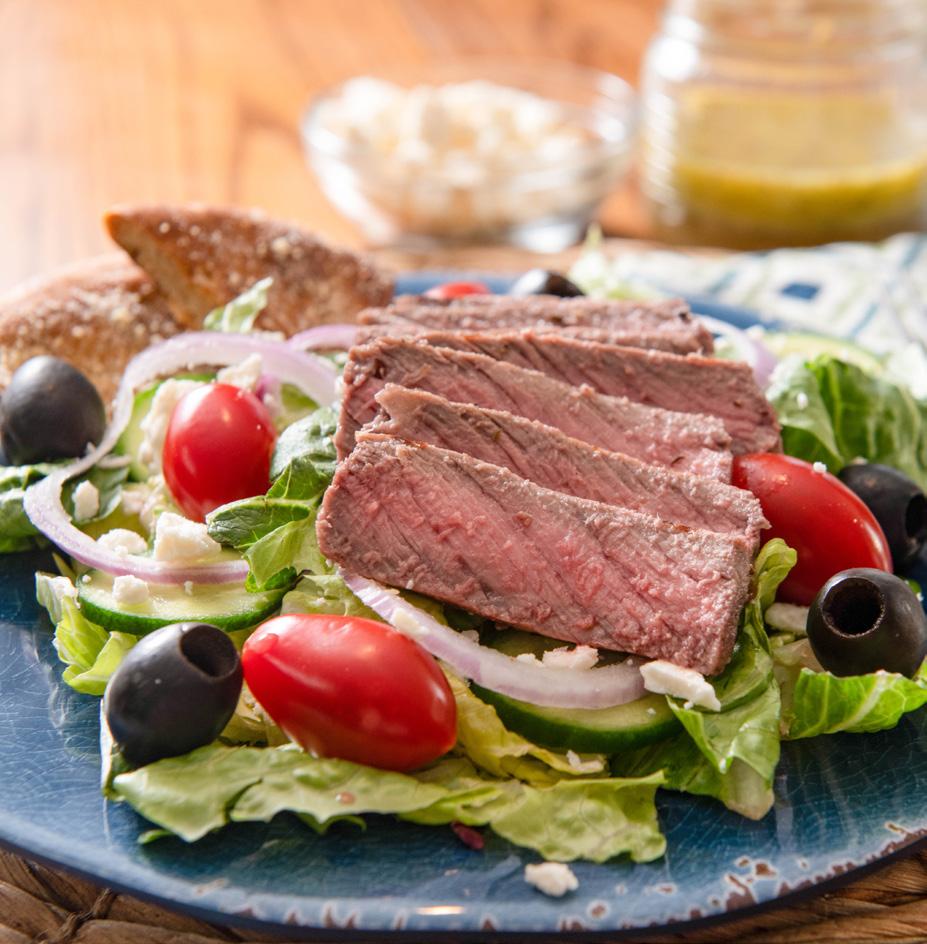
1 pound beef top sirloin or flank steak, cut ¾-inch thick
6 cups torn romaine lettuce
1 medium cucumber, thinly sliced
½ small red onion, cut into thin slices
2 tablespoons crumbled feta cheese
8 Greek or ripe olives (optional)
2 pita breads, toasted, cut into wedges
2/3 cup fresh lemon juice
2 teaspoons dried oregano
1/3 cup olive oil
½ teaspoon salt
½ teaspoon black pepper
Whisk marinade ingredients in small bowl. Place steak and half of marinade in foodsafe plastic bag; turn to coat. Close bag securely and marinate in refrigerator
6 hours or overnight, turning occasionally. Reserve remaining marinade.
GET READY FOR YOUR NEXT GRILL OUT! VISIT iowafoodandfamily.com/ magazine/grilling FOR YOUR CHANCE TO WIN A $100 GRILLING GIFT BASKET.
Remove steak; discard marinade. To grill, place steak on grid over medium, ash-covered coals. Grill, covered, 7 to 11 minutes (over medium heat on preheated gas grill, covered, 8 to 13 minutes) for medium rare (145 degrees F), turning occasionally. Do not overcook. Remove; let stand 10 minutes. Carve into thin slices.
Combine beef, lettuce, cucumber and onion in large bowl. Add reserved marinade; toss. Sprinkle with cheese and olives. Serve with pita wedges.
31 g protein, 450 calories, 25g total fat, 5g saturated fat, 75mg cholesterol, 560mg sodium, 27g total carbohydrate, 2g fiber
Source: www.beefitswhatsfordinner.com
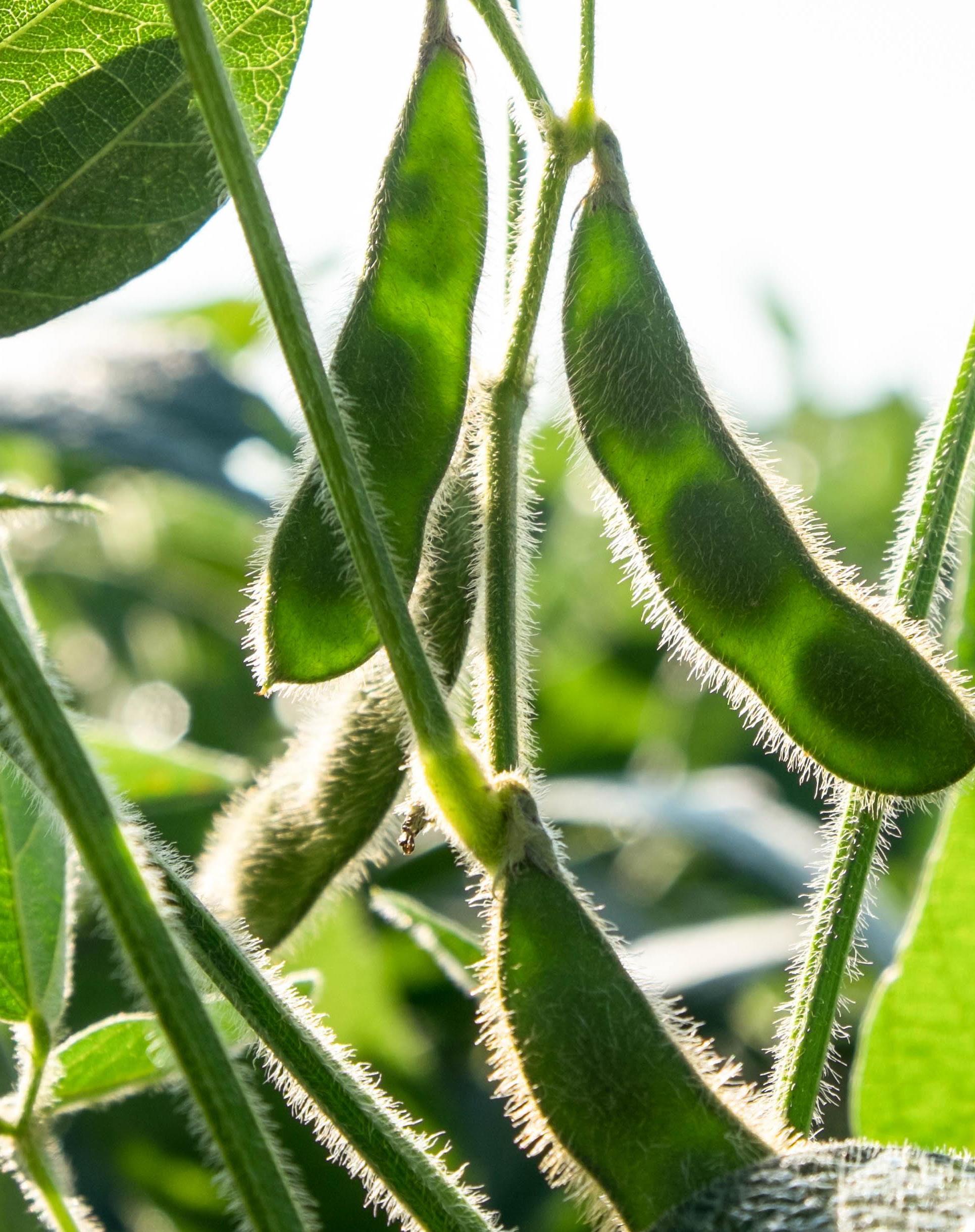

 By
By
FROM SOIL SAMPLES TO AERIAL IMAGING, DATA POINTS COME TOGETHER, GIVING FARMERS POWERFUL PRECISION IN THE FIELD.
Darcy Dougherty Maulsby | Photos by Joseph L. MurphyFarmers only get one chance each year to plant their crop correctly and get the young seedlings get off to a good start. Thanks to modern technology, powerful data at farmers’ fingertips helps maximize their crops’ potential, from start to finish.
Harnessing the power of this data is giving farmers a new way to meet many of the age-old challenges that make agriculture endlessly complicated.
“Farming is simple, but not easy,” says Chad Hafkey, a corn and soybean grower who has farmed in the Grinnell area full time since 1996. “It’s simple, meaning we’re trying to grow the best crops possible, but it’s complicated because of unpredictable weather, volatile markets and other challenges.”
Fortunately, the state’s farmers have some key advantages since
Iowa is in the epicenter of ag innovation. Tools ranging from global positioning systems (GPS) in outer space to sophisticated monitoring systems on today’s farm equipment are helping farmers meet the challenge of raising more crops on a fixed amount of land, including areas where urban communities are expanding into precious farmland.
“Good farm managers want to be good stewards of the land,” says Hafkey, a fifth-generation farmer. “Precision ag technology makes this more effective.”
Precision farming solutions connect each phase of crop production – sometimes down to the square inch – to increase efficiency, maximize yield potential and enhance conservation. Much of this
starts with sampling the soil to understand what nutrients are present.
Grid soil sampling measures key soil nutrients, including potassium and phosphorus. These are vital to plant growth and health, just like vitamins and nutrients are essential in keeping people healthy.
With grid sampling, soil samples are typically collected from incremental 2.5-acre grids across the field. After the samples have been collected and analyzed by a soil-testing lab, a map is created to show areas of high fertility, adequate fertility and low fertility. It helps farmers to know how nutrient needs differ across the field. This allows farmers to fine-tune their fertilizer applications, adding nutrients where they are needed to grow a healthy crop and cutting back where nutrients are not needed.

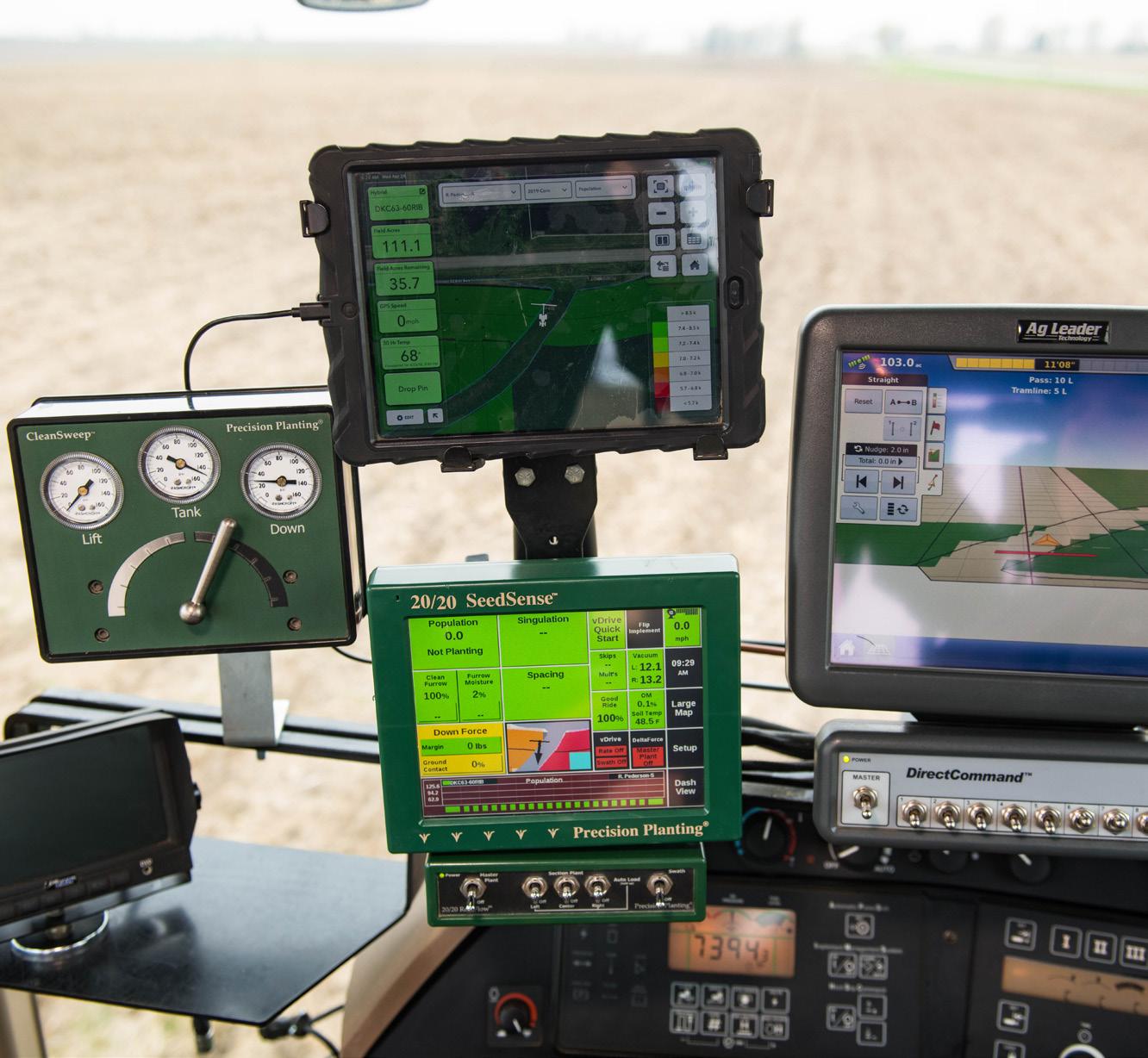
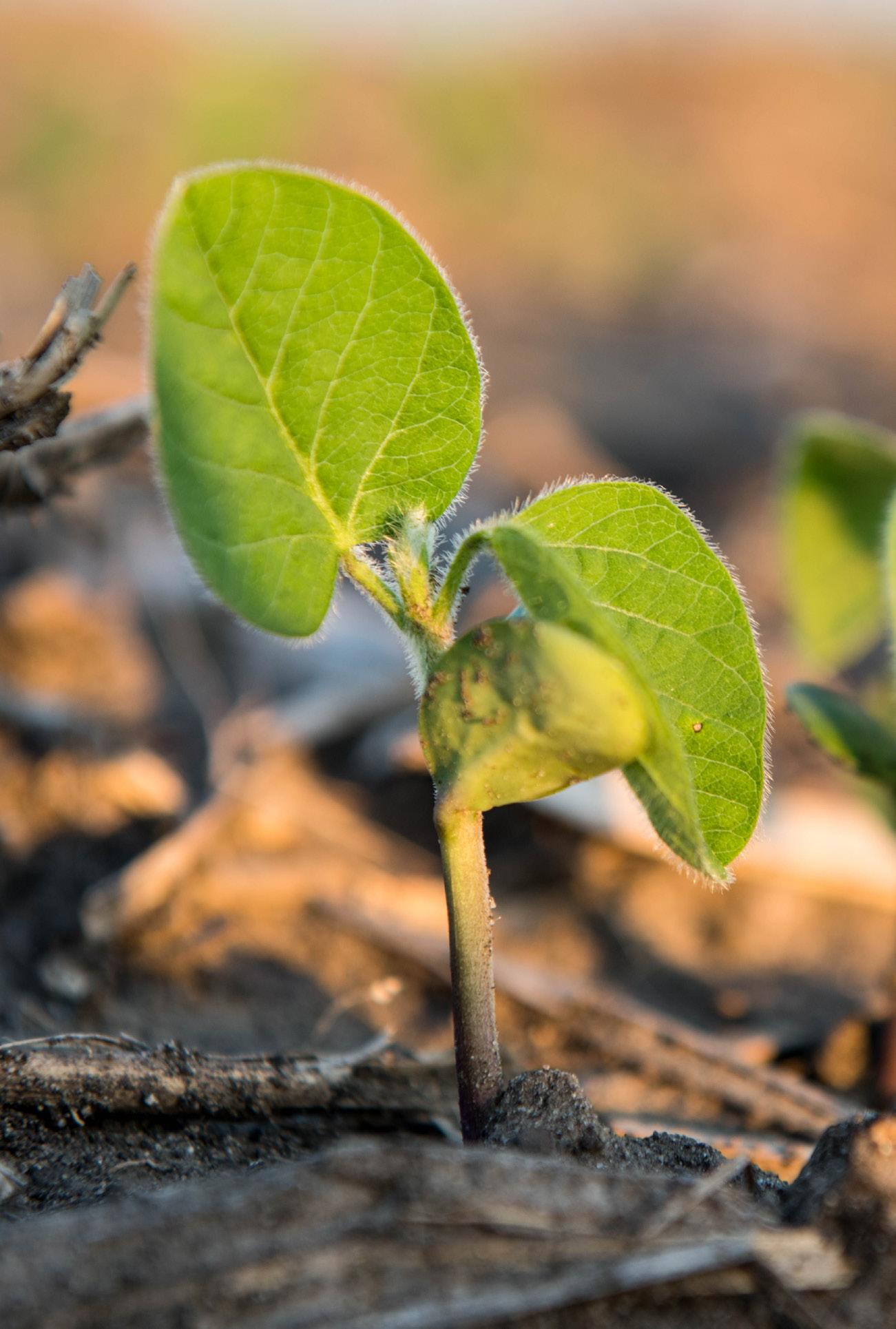
The Hafkey family relies on grid soil sampling, one of the first precision ag technologies to gain widespread use in the 1990s. “My dad started using grid soil sampling back when I was in high school,” Hafkey says.
Before grid soil sampling technology was developed, farmers used composite soil samples. In this system, a variety of soil samples were collected across the field, mixed together and sent to a soil-testing lab as one sample. This provided a general overview of nutrient levels in a field, but it provided no information about the variability of soil nutrient levels within the field.
TAKING MORE OF THE GUESSWORK OUT OF FARMING
Grid sampling unleashed a new era of precision agriculture that continues to revolutionize farming today, making it more efficient and sustainable from planting to harvest. It’s similar to the way technology has transformed vehicles in the past 25 years.
“Think about the computers that monitor tire pressure and fuel mileage real-time in your car,” says Cory DeJong, a Key Cooperative agronomic data manager who works with Hafkey. “The more information you have, the more informed decisions you can make to prevent potential problems and enjoy a better ride.”
GRID SAMPLING UNLEASHED A NEW ERA OF PRECISION AGRICULTURE THAT CONTINUES TO REVOLUTIONIZE FARMING TODAY.

 Farmers use data from grid sampling, GPS systems and their equipment to be as efficient as possible.
A soybean emerges from the soil. The nutrients in the soil allow the plant to grow and thrive.
Farmers use data from grid sampling, GPS systems and their equipment to be as efficient as possible.
A soybean emerges from the soil. The nutrients in the soil allow the plant to grow and thrive.
The same is true for a new generation of tech-savvy farmers like Hafkey and precision-ag specialists like DeJong who support them. These precision ag technicians rely on problem-solving skills – math, science, mechanical aptitude, computer knowledge –and communication skills to work directly with farmers to improve the efficiency of their businesses like never before.

GROWERS CAN ACCESS REAL-TIME DATA ABOUT WHAT’S HAPPENING IN THEIR FIELDS AT ANY MOMENT.

“You can’t manage what you don’t measure,” says Nick Lacaeyse, a precision ag specialist with Key Cooperative in central Iowa. “It’s exciting to have new tools to help farmers analyze the data they’re collecting to fine-tune what works best on their acres.”
Thanks to apps on farmers’ smartphones and tablet computers, growers can access real-time data about what’s happening in their fields at any moment.
Theses apps can notify farmers about how much precipitation accumulated in the past 24 hours on specific fields. This “digital rain gauge” helps them decide whether the ground will be too wet or dry enough to work. Having all this information at their fingertips saves farmers time, since they don’t have to travel from field to field to check actual rain gauges.
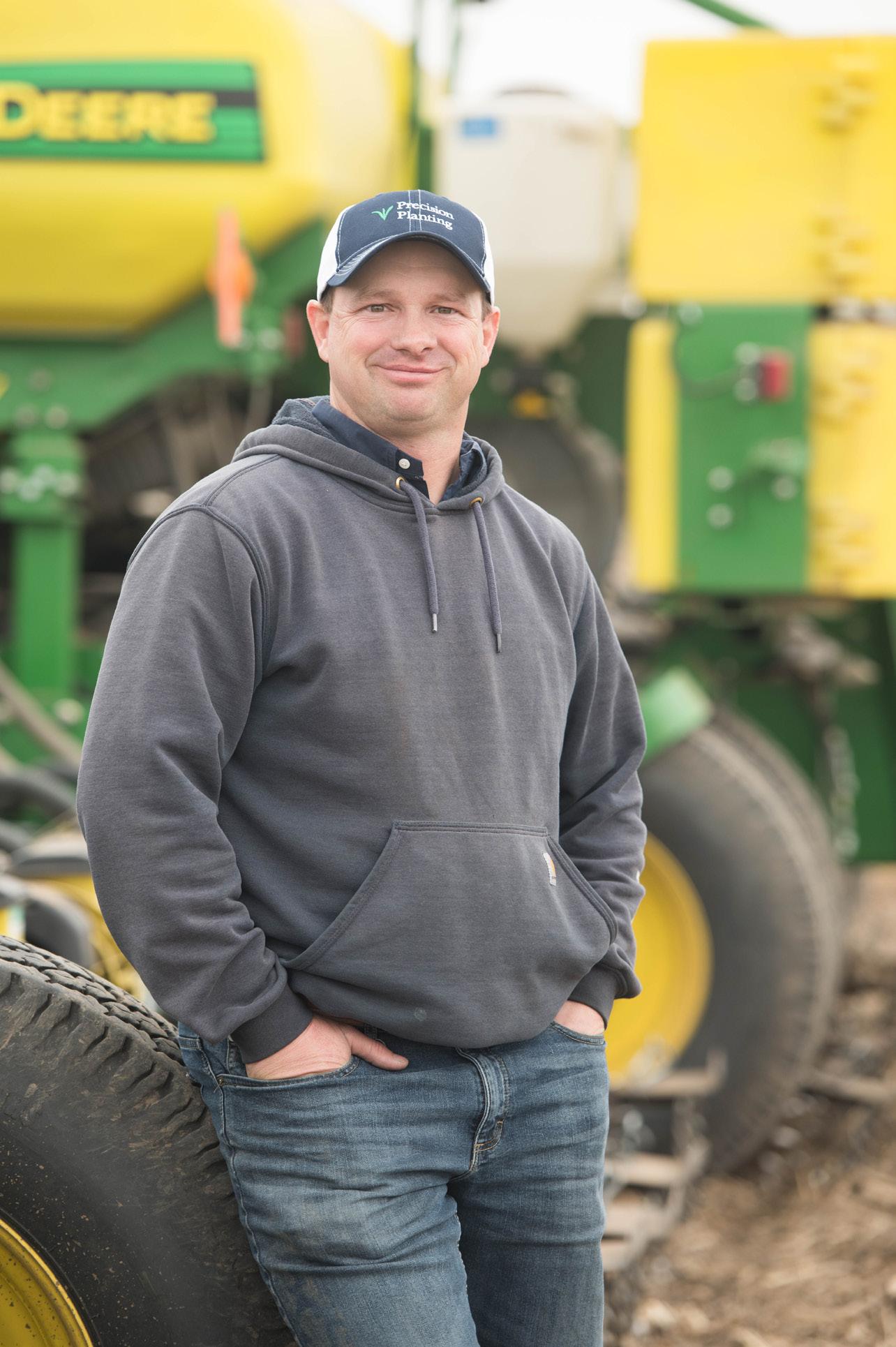
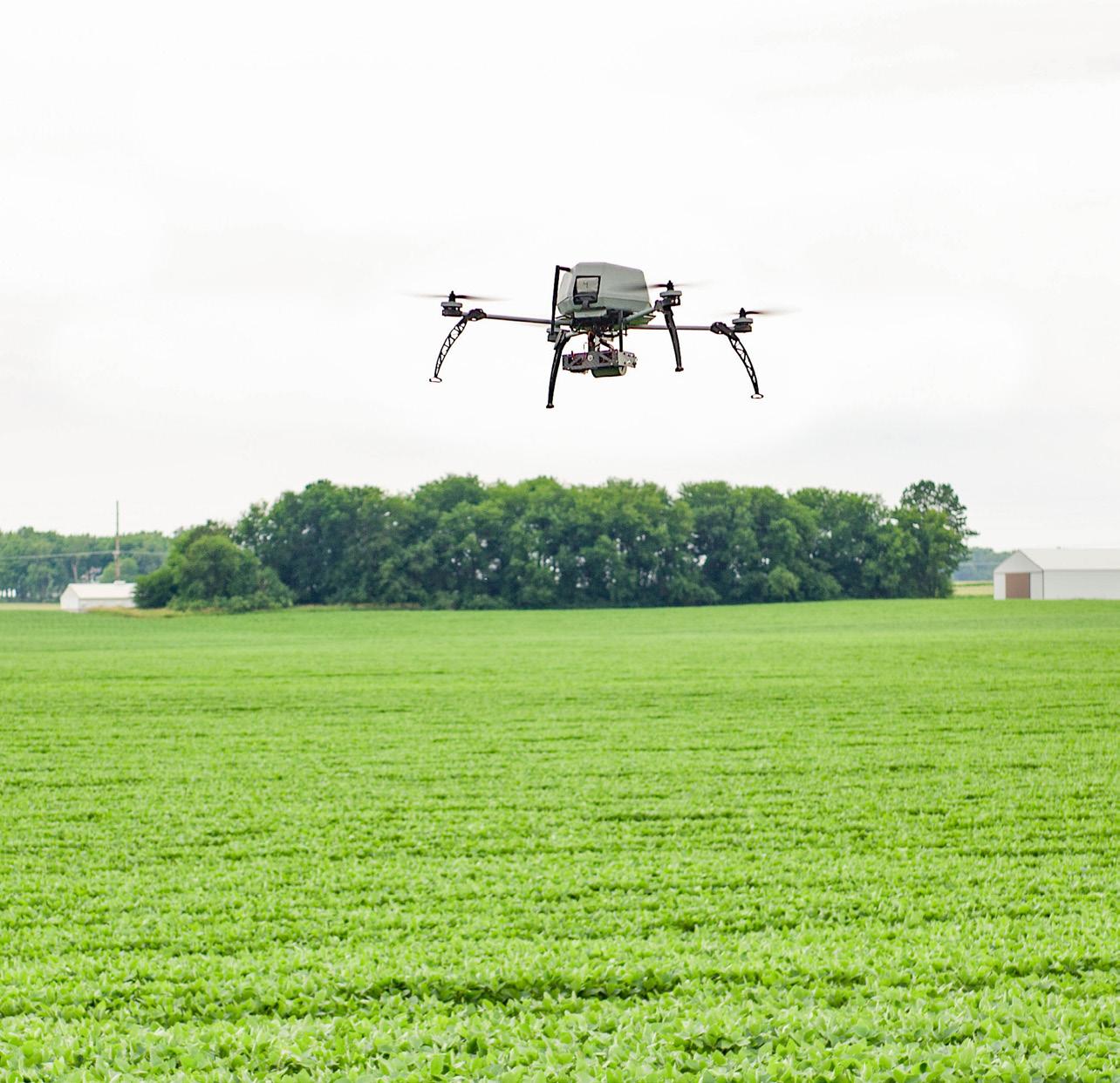 Some precision ag tools incorporate aerial images taken by drones.
Chad Hafkey partners with precision-ag specialists at Key Cooperative to make smarter management decisions.
Some precision ag tools incorporate aerial images taken by drones.
Chad Hafkey partners with precision-ag specialists at Key Cooperative to make smarter management decisions.
Other precision ag tools incorporate aerial images of fields taken by drones and satellites. These images generate color-coded maps that reveal how the crops are growing. This is especially useful as corn grows tall, making it harder to assess fields from the ground. It also helps farmers identify which fields might be facing crophealth issues like plant diseases.
All the data points collected through grid sampling, aerial images and specialty apps can be uploaded to the cloud in secure systems accessible only by the farmer and anyone he or she allows to see the data. Hafkey and his agronomic advisors at Key Cooperative use this information as they plan next year’s crop.
Since no two fields are alike, and soil types are often different within the same field, Hafkey and his team create management zones to account for higher-yielding and loweryielding areas. Key Cooperative agronomists use the data Hafkey collects throughout the year to write prescriptions for variable-rate planting (where different seed genetics are planted in areas of the field where they have the best chance
to thrive), variable-rate fertilizer applications and more.
“As I look at my data, I’m always asking ‘what if’ questions to understand what’s affecting my crop and how I can do a better job,” Hafkey says.
Hafkey has long enjoyed adopting precision ag technology, which creates economic and environmental opportunities. He started in the late 1990s with a yield monitor in his combine to track yields in real-time when harvesting corn and soybeans. Next came auto-steer technology around 2005-2006.
Auto-steer relies on GPS signals from satellites, just like the GPS navigation system in your vehicle uses these signals to guide you to a specific destination. Auto-steer is useful in farming, because it can guide the machinery precisely and prevent overlap when farmers are planting seeds or applying crop protection products or fertilizer. This improves efficiency, ensuring seeds, fertilizer or crop protection products are applied across a field only as necessary.
“This level of precision lets you place inputs like fertilizer where they’ll do the most good,” Lacaeyse says. “It also saves the farmer money and helps protect the environment.”
As precision ag technology continues to evolve, it’s creating new options for farmers like Hafkey.
“Collecting data from my farm and analyzing the numbers helps us establish benchmarks so we can keep improving,” says Hafkey, who conducts on-farm research trials each year with Key Cooperative. “Then we can make smarter management decisions.”
It’s exciting to help provide these solutions to farmers, DeJong adds. “Technology adds a layer of clarity that helps farmers produce higher yields while using resources more efficiently.”
This is important to Hafkey, who works hard to create a culture of sustainability that will benefit generations to come. “If you’re not trying to get better, you’re falling behind,” he says.
ANALYZING THE NUMBERS HELPS US ESTABLISH BENCHMARKS SO WE CAN KEEP IMPROVING.
-CHAD HAFKEY

On a country road in the quiet rolling hills of southeast Iowa, a farm turns into a charming, rustic outdoor Friday evening dining destination.
At this picturesque pizzeria on Julia and Mike McNurlen’s farm near Wellman, patrons flock from surrounding communities for brick-oven pizza, entertainment and a slice of country life that’s as magical as the pizza.
Since 2012, outdoor diners have gathered for Stone Wall Pizza’s iconic Pizza on the Farm. Upon arrival, the aroma of hickory wood gently wafts through the air, offering newcomers a taste of what’s to come.
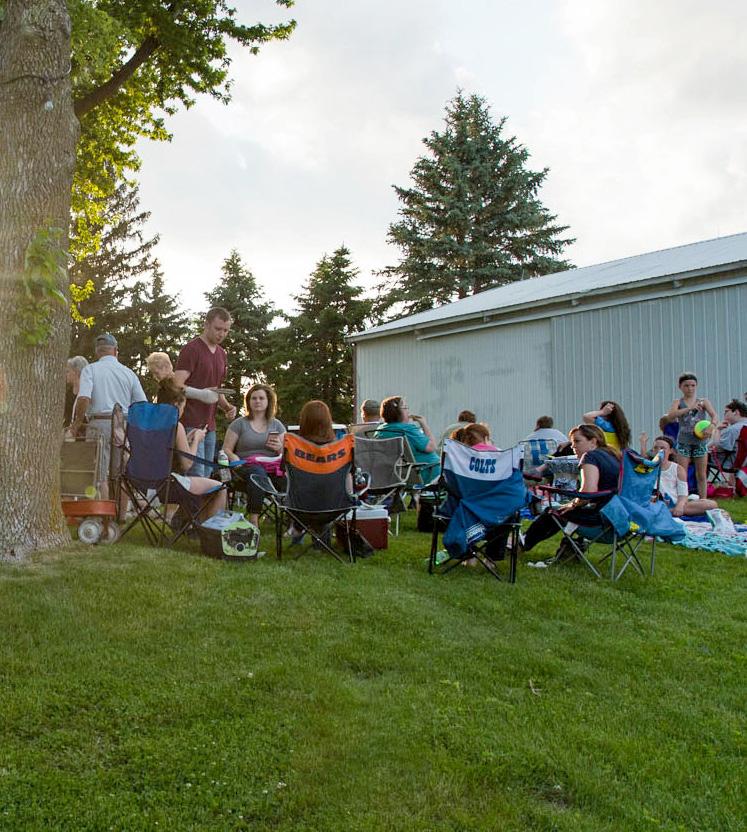
Amid the scenic views of lush corn and soybean fields, visitors are treated to fresh country air, the sounds of birds singing and crickets chirping, and children laughing as they push one another on a swing hanging from a giant oak tree. Nearby, adults relax in their lawn chairs or by sitting on bales of hay adorned with quilts. It’s a setting rooted in Iowa’s enviable rural landscape.
The McNurlens are the fourthgeneration to own the family farm. It was once Julia’s great grandparents and grandparents, then her parents and now where the couple raises their family. It’s the home, heritage and experiences they treasured and
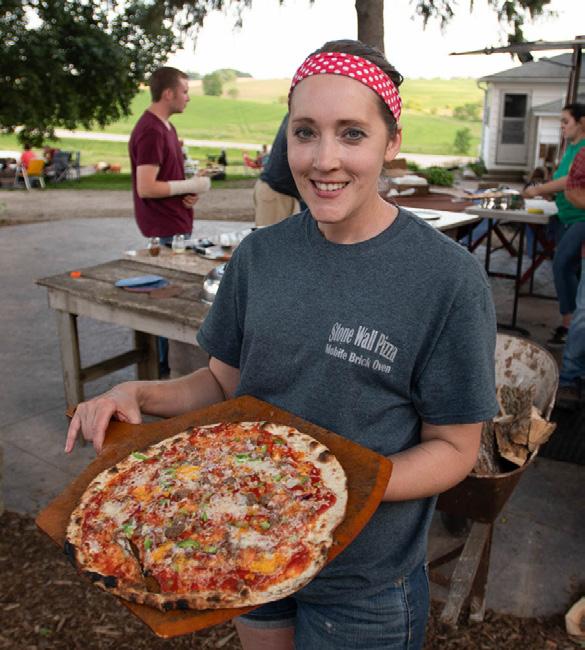

envisioned for their children, now 12 and 5.
When Mike and Julia were engaged, they bought a mobile brick oven from California.
“Mike always dreamed of having a brick oven. A mason by trade, he built the oven’s façade using salvaged red bricks,” Julia explains.
After much trial and error –practicing the wood-cooking technique and experimenting with dough, herbs, sauces and toppings – the duo had created something special. And,
Wall Pizza was born.
 Julia McNurlen (center) began Stone Wall Pizza in 2012. The pizzeria delights guests with fresh toppings and scenic views.
Stone
Julia McNurlen (center) began Stone Wall Pizza in 2012. The pizzeria delights guests with fresh toppings and scenic views.
Stone
“Mike’s uncle runs a sawmill, and we use the bark-covered hickory wood the mill can’t use,” Julia explains. “It’s the ideal wood for heating the ovens 700 to 1,000 degrees F, which perfectly cooks a pizza in two minutes.”
Cooking pizza quickly is essential in this lively atmosphere, as they craft 125 to 175 pizzas every Friday night. On the first Friday of each month, live music on the grassy stage beneath white lights strung between trees adds to the rustic ambiance. When live music coincides with Pizza on the Farm, they always have two – and sometimes three – brick ovens fired up.
For the big oven, which sits behind their farmhouse, Julia starts heating it in the morning to be ready for the evening’s crowd. The mobile units heat up in two hours.
When it’s time to cook, the fire is moved to the back of the oven, and each pizza is pushed by hand on peels. A peel is a shovellike tool used by bakers to slide loaves of bread, pizzas, pastries and other baked goods in and out of an oven. Its flat carrying surface holds the pizza and a long handle extends from one side of the surface. The thin edge of the peel allows users to move and turn pizzas with precision.
While pizza – a quintessential food favorite that spans generations – may have originated in Italy, its ties to Iowa are as robust as the toppings themselves.
From meat toppings, such as beef and pork, to vegetable toppings, including sweet corn and edamame – all covered

with cheese, Iowa farmers likely contributed to growing or raising the food.
“We source ingredients from local farms and businesses,” Julia says. “We grate all our own cheese so that it’s always fresh. We go through 50 to 60 pounds of cheese each week for Pizza on the Farm.”
While mozzarella is the clear frontrunner as a topping favorite, they also use smoked gouda, cheddar and parmesan.
Their dough recipe is a secret, with Julia only letting on that a special blend of herbs in the slow-proofed dough creates the amazing flavor.
It’s often a blank canvas for the McNurlens or any of the six to eight people helping on a Friday night to create a savory masterpiece.
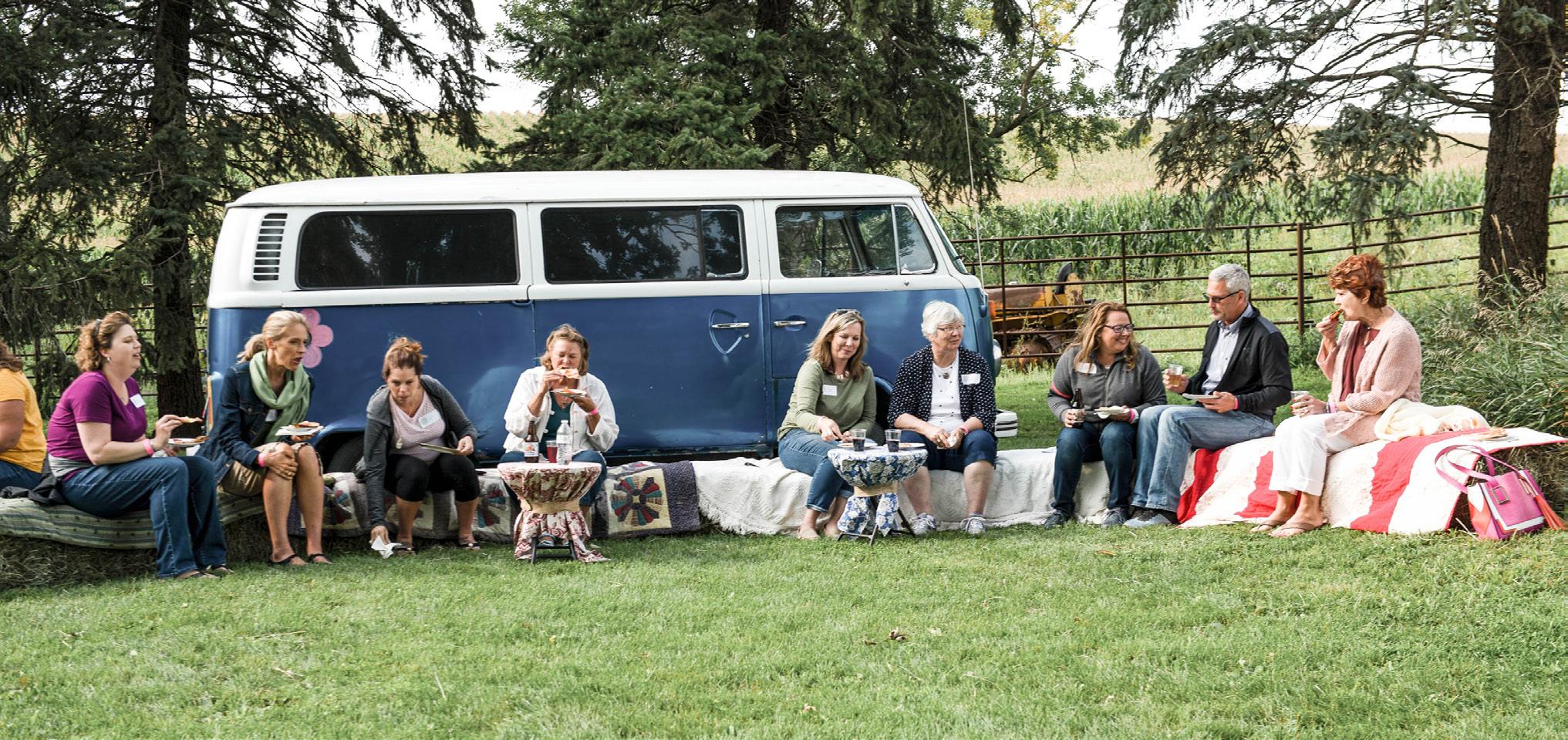 Guests on the Iowa Food & Family Project's annual Expedition Farm Country tour enjoy the flavors of Pizza on the Farm.
Guests on the Iowa Food & Family Project's annual Expedition Farm Country tour enjoy the flavors of Pizza on the Farm.
Where
3297 320th Street Wellman, Iowa 52356
When
Pizza on the Farm is from 5-8 p.m. almost every Friday from May through October. Check the event calendar at stonewallpizza.com before going.
“It’s all about creating an experience and having fun,” Julia adds.
which adds to the flair Stone Wall Pizza brings to catering events.
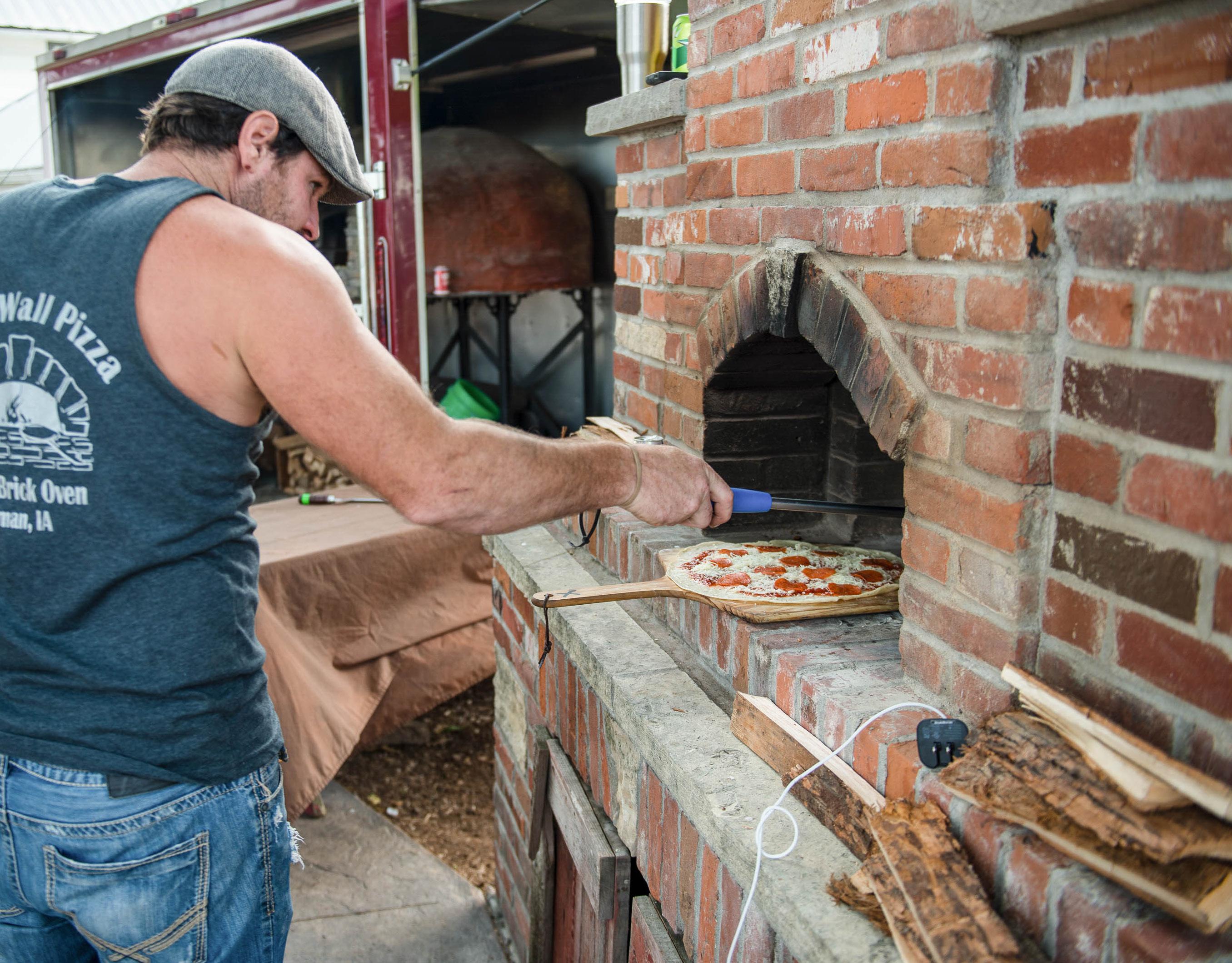
If the pizza line starts getting long, it’s not uncommon to find Julia in line amid the pizza lovers, handing out slices while they wait. Her parents live on an adjoining farm and often find themselves rolling up their sleeves to help on a moment’s notice.
The McNurlens have built a popular pizza fanfare. Julia primarily runs the business, since Mike also works in masonry, and as a speech coach and DJ.
They now have two additional mobile ovens and cater 50-60 events, ranging from graduation parties to wedding receptions, each year. One of the ovens is pulled by an old ambulance that a nearby farmer sold to the McNurlens,
“Mike found the retired ambulance and was impressed with its airtight doors and expansive storage,” Julia says.
For catering events, the two most popular pizzas are their margherita and chicken ranch varieties, made with local ingredients and homemade recipes. The margherita is a nod to pizza’s Italian heritage, with red tomatoes, green basil and white mozzarella sourced from a local Community Supported Agriculture (CSA) program. The olive oil comes from Pickle Creek Herbs in Fairfield.
Pizza on the Farm is a true Iowa gem, a memorable combination of food, family and community tucked in Iowa’s beautiful country landscape.

With a scenic view, bring a blanket or chair and beverage of choice to enjoy. Groups of more than 10 are encouraged to call ahead.
$12 all-you-can-eat buffet; kids’ pricing for those between the ages of 3 and 9 is $1 for every year of age. Music and other entertainment are free. Local wineries and breweries are often on-site offering beverages for purchase.


The eastern Iowa community of Donahue in Scott County tallied a population of 346 in the last census. A stone’s throw northwest of town sits Cinnamon Ridge Farms – a world-class dairy, which attracts nearly twice as many visitors every month as the town’s entire population.
It’s at Cinnamon Ridge Farms where farmers from nearly 60 countries, U.S. bankers, Road Scholars, parents and children come to learn about modern agriculture. Each year, 6,000 visitors get an up-close farm experience by seeing everything from high-tech robots milking Jersey dairy cows to sustainability in action with the recycling of food waste.
John Maxwell is a fifth-generation Jersey dairy farmer. He lives on the Century Farm where his mother once lived, and operates an amazing dairy with his wife Joan and daughter Amy.
“I grew up on a diversified dairy farm,” John explains. “I learned a lot of trades by working with different animals and crops, such as mechanics and carpentry. After graduating from the University of Iowa in 1984 with a degree in psychology, I soon returned to the farm.”
With a mere 20 cows to his name –
compared to the 250 he has today – John’s first break came in 1988 when he purchased 180 acres of land for $800 per acre. Iowa was amid the farm crisis and land was inexpensive.
“My next break came in 1997 when I received the National Outstanding Young Farmer Award from John Deere,” John says. “We agreed to give farm tours for John Deere, and it’s where our story took off.”
Two decades later, when global agriculture manufacturing giant John Deere has foreign visitors or customers at its corporate offices in nearby Moline, Illinois, they go to Cinnamon Ridge Farms.
It’s not because of geographic proximity that this farm has remained a global attraction, but the way this family masters the ultimate trifecta of technology, sustainability and values.
The farmers – from countries, such as Germany, Brazil, Australia and Lithuania, or members of the Global Farmer Network – come to Cinnamon Ridge Farms to learn about how to improve farming in their corners of the world. They join the Maxwells around the dinner table, feasting on shared knowledge and the fruits of hard labor.
“As farmers, we’re all in this together; working to feed the world. If we can
work together, we’ll all succeed, John says.
“Visitors often ask us what the magic bullet is for high milk production. It doesn’t boil down to one thing; it’s all the little things, including making sure the cows are comfortable and the barns are clean. It’s ensuring the water is continuously clean and fresh. We are constantly evaluating our processes, and we either validate it’s the best way or we change it.”
Since late 2012, the Maxwell’s Jersey cows have been milked using robotic technology. John’s
daughter Amy is the farm’s dairy manager, and following graduation from Iowa State University, she encouraged the family to make the leap into robotic technology.
With cows wearing Fitbit-type devices, robotic milking allows the Maxwells to monitor more than 100 data points for every cow. The robotic machinery – costing about $250,000 each – detects the cow’s udder and washes it with a cleaning solution before attaching the milking mechanism. While the robots are working 24 hours a day, each cow is milked just as often as needed, sometimes five or six times a day.

A S FARMERS, WE’RE ALL IN THIS TOGETHER; WORKING TO FEED THE WORLD. IF WE CAN WORK TOGETHER, WE’LL ALL SUCCEED.
-JOHN MAXWELL
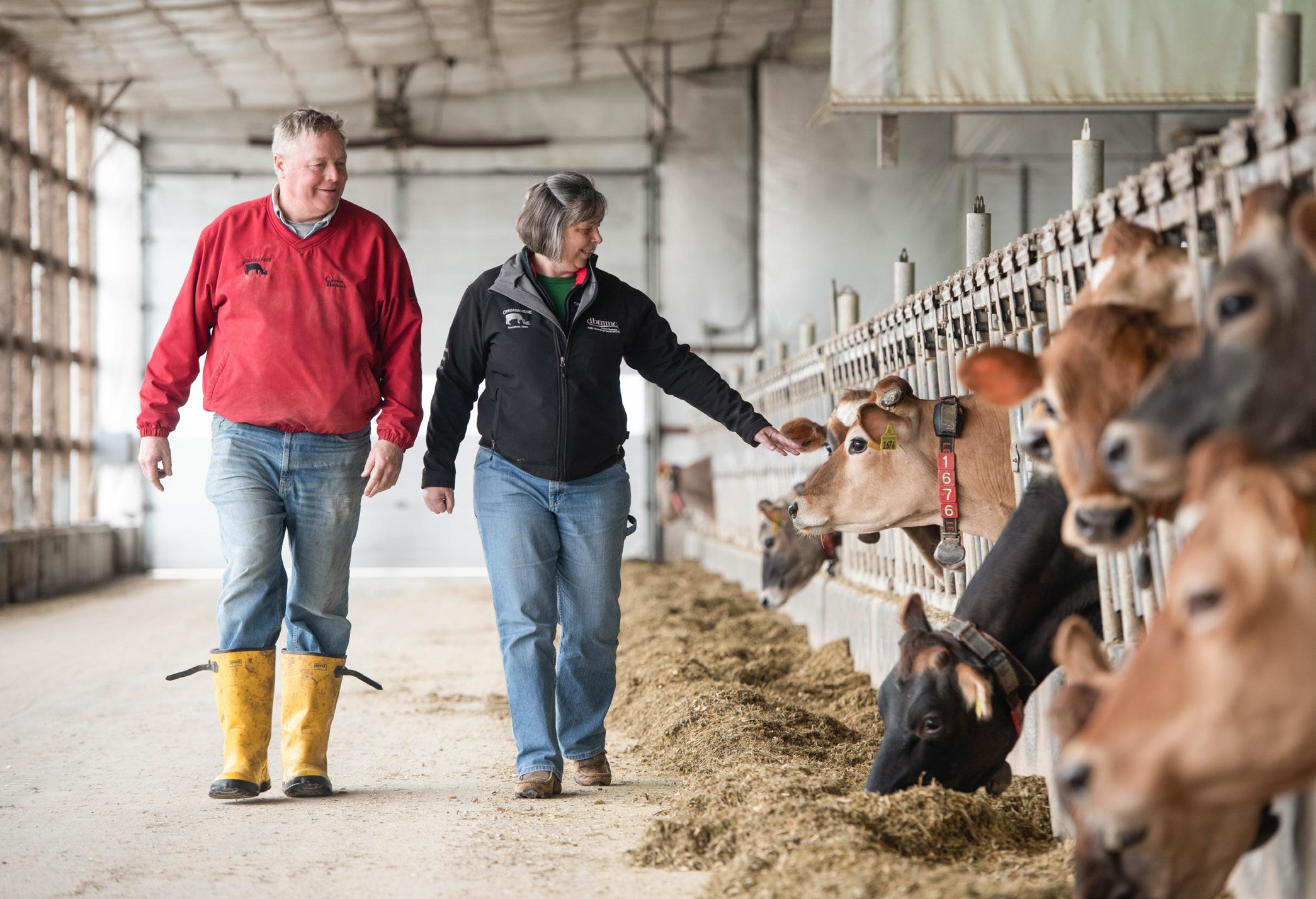
Joan is passionate about analyzing data and thrives on having more information.
With smartphones or large-screen monitors, the Maxwells can see each cow’s data, including how many steps she’s taken, how much food or water she’s consumed, her weight or if it’s time for breeding.
“The data points we have now are amazing. But, it’s not just one piece of technology that contributes to success. It’s a combination of all of the things we do – working together in sync,” Joan says.
While the robotic technology is
fascinating and gaining popularity, the Jersey breed of dairy cows has its own claim to fame – especially at Cinnamon Ridge Farms.
Jersey cows originated on the island of Jersey, a small British island off the coast of France. The Jersey is one of the oldest dairy breeds and were brought to the U.S. in the 1850s. Their milk is higher in fat and protein and is popular in making products such as cheese. Because of their milk’s 5% fat content, 6 pounds of milk will yield 1 pound of cheese. Other dairy cows produce milk that is
3.5% fat, with 10 pounds of milk needed to produce 1 pound of cheese.
Among farms with Jersey cows, Cinnamon Ridge Farms is No. 2 in the nation for milk production and No. 1 for protein content (average based on herd size).
The cows’ feed rations – with oversight from the farm’s nutritionist – consist of corn, alfalfa and soybean meal, which are grown right at Cinnamon Ridge Farms. Plus, some unconventional food, such as cake mix and coffee creamer are part of the rations, earning the Maxwells a reputation as the ultimate recyclers.
The nutritionist working for Cinnamon Ridge Farms also leads a food waste center. Together, John and the nutritionist decided to add cake mix and coffee creamer to the cows’ rations. The products that would otherwise be destined for a landfill are making the Jerseys happier – as demonstrated by improved milk production.
Beyond the farmers who tour Cinnamon Ridge Farms, the farm attracts another 2,000 guests annually who are a wellproportioned mix of kids and adults.
As part of their sustainable operation, the farm features
honeybees, pollinator habits and baby chicks.
“We want to show visitors how well the animals are cared for, so when they’re buying cheese or yogurt at the grocery store, they feel good about the food,” John explains.
When kids visit, they take a wagon ride to see corn, soybeans and cover crops. They see crops that have been harvested into silage and learn how different cows need different diets based on their ages. The next stop is seeing the cows milked behind a glass window. And of course, the tour ends with ice cream.
“Connecting the dots for people
and showing them how much we care is one of our most important jobs,” Joan says. “When we leave the milking barn and go upstairs to the free stall barn, visitors see the cows eating, laying down on sand or hay beds, getting scratched and feeling comfortable.”
“When people ask me what the most important thing is for sustainability, I think it’s vitally important for farmers to share their stories,” John adds. “Inviting people to visit our farm shows visitors how passionately we care about the land and our livestock.”
Cinnamon Ridge Farms is striving to be the No. 1 producing Jersey herd in the nation, and they are well on their way.




8 ears fresh sweet corn, shucked
5 cups heavy cream
4 cups whole milk
1½ cups sugar, divided
14 large egg yolks
¼ teaspoon salt
2 tablespoons vanilla extract
BLACKBERRY SAUCE
1 cup sugar
½ cup water
2 pints fresh blackberries
Whisk egg yolks and remaining ½cup sugar together in a bowl. Stir 1 cup of hot cream mixture into the yolk mixture to temper, then slowly pour the egg mixture into the cream mixture, whisking constantly.
Return the pot to the stove and cook over medium-low heat, stirring frequently, until mixture thickens and coats a spoon. This should take about 10 minutes.
Cinnamon Ridge Farms was the recipient of a 2019 U.S. Dairy Sustainability Award presented in May by the Innovation Center for U.S. Dairy ® . The award recognizes dairy farms, businesses and collaborative partnerships that demonstrate outstanding economic, environmental and social benefits; a longstanding commitment to continuous improvement; and a replicable model to inform and inspire others in advancing dairy sustainability leadership.
2 teaspoons lemon juice
Cut kernels off the ears of corn and place in a large pot; break cobs in half and add to the pot. Add cream, milk and 1 cup of sugar. Stir well and bring to a boil over medium-high heat.
Turn off heat, remove the corn cobs (do not throw away). Use an immersion mixer or blender to puree the mixture, then return the cobs to the pot.
Let the mixture stand for about 2 hours, keeping warm over the lowest stove setting.
After 2 hours, bring the mixture back to a simmer then remove from heat. Remove and discard the corn cobs.
Finally, pour ice cream mixture though a fine sieve or strainer into a container to remove pieces of corn. Chill the mixture for at least 4 hours or overnight before freezing in an ice cream maker according to manufacturer’s directions.
To make the blackberry sauce, bring water and sugar to a boil in a large saucepan. Add blackberries and cook for about 10 minutes or until the berries start to break down. Add lemon juice and remove from heat. Use an immersion mixer or a blender to puree the blackberry sauce and then strain the sauce through a fine sieve or cheesecloth to get rid of the seeds. Refrigerate sauce until ready to serve.
To serve, scoop the sweet corn ice cream into serving bowls and top with blackberry sauce.
728 calor ies, 46g total fat, 390mg cholesterol, 133mg sodium, 74g carbrohydrates, 5g fiber, 11g protein
Source: Sara Ross, farmer from Pottawattamie County Serves 12

BASEBALL IS THE SOUNDTRACK OF SUMMER. WHETHER REMINISCING ABOUT THE GLORY DAYS OR ANTICIPATING AN UPCOMING SEASON, IT IS AN ICONIC COMBINATION OF HOT DOGS AND BALL CAPS, PEANUTS AND CRACKER JACKS.

 By Lauren Houska | Photos by Joseph L. Murphy
By Lauren Houska | Photos by Joseph L. Murphy
Believe it or not, soybeans play a big role in gameday glory at the University of Iowa Duane Banks Stadium. While the Iowa City field may look like real grass, it’s actually artificial turf made with soybeans.
AstroTurf®, an artificial turf company that specializes in sports turf, created a product that replaces 60% of the petroleum oil-based polyurethane used in the backing of the turf with soybean oil. It’s made in America
with U.S.-grown soybean oil.
Using soybeans in artificial turf might seem a little out of left field, but it’s a technology that farmers and researchers worked to develop for years.
U.S. soybean farmers have produced a record soybean crop for the last six years and are always looking for new product uses. A large percentage of Iowagrown soybeans are crushed into meal for livestock feed — yes, soybean farmers also had a hand in
those delicious ballpark hot dogs!
When soybeans are crushed into meal, oil is created as a byproduct. Farmers need new, innovative ways to market this oil — and this artificial turf is one example.
It takes approximately five acres of soybeans to produce the backing for a typical baseball field. This makes each field a home run for soybean farmers and the Duane Banks Baseball Stadium a “field of dreams” for the Iowa Hawkeye baseball team.
The University of Iowa is wellknown for its famous “America Needs Farmers” (ANF) logo, a testament born from the football program and shared by head baseball coach Rick Heller and the Hawkeye baseball team.
“Being in a farm state and being a farm kid myself, it makes me extremely happy to know soybeans help make this the highquality field it is,” says Heller.
The two-phase project was completed in 2015. Heller says the durability and reduced maintenence time – it requires no mowing or weed control – have proven to be winning benefits.
Heller and the century-old Hawkeye baseball team also see the environmental benefits to
their field, which never needs to be watered.
According to AstroTurf, each synthetic field can save millions of gallons of water per year.
“We have a lot of pride being from the state of Iowa,” Heller says. “We’re happy this turf can be a small way to show our support for Iowa farmers.”
Tom Hanks’ “A League of Their Own” character Coach Jimmy Dugan made it very clear “there’s no crying in baseball,” but it’s especially true for AstroTurf, which is designed with safety as the top priority.
The soy-based backing helps lock synthetic grass fibers in place for optimal traction and cleat release, reducing torque that’s transmitted
to knees and ankles. This benefit has proven to result in fewer injuries.
The fields also offer excellent shock absorption and antimicrobial treatments provide protection against mold, mildew, algae and bacteria.
“Our success, especially in farming states like Iowa, is in large part a direct result of farmers,” says Sydney Stahlbaum, director of sales support for AstroTurf.
She says AstroTurf is committed to helping clients reduce their carbon footprints. Harnessing the power of sustainable, renewable resources — like soybeans — is a key way the company reduces the environmental impact of their products.




U.S. soybean farmers are heavy hitters when it comes to sustainability. They’ve implemented sustainable practices on their farms for years and are committed to stewardship of air, water and soil.
In fact, they’ve knocked it out of the park over the last 30 years. According to research conducted by the United Soybean Board (USB), the nation’s soybean farmers use 40% less land, 35% less energy, 33% less water and contribute 44% less in greenhouse gas emissions than just three decades ago. USB says the industry’s goal is to improve each of these areas another 10% by 2025.
“We’re thankful for farmers who grow the soybeans that help us make a greener product for the rest of the world,” Stahlbaum says.


The success of Iowa farmers has been hard fought with generations of work, sweat and sacrifice.
Nearly 20,000 Iowa family farms went bankrupt during the 1980s Farm Crisis, ending generations of farm legacies. Nationally, the crisis claimed nearly 235,000 family farms.
At the time, University of Iowa head football coach Hayden Fry knew many of his players and most of the fans were impacted by the crisis in some way. As he worked to rebuild the Hawkeye football legacy, Fry also went to work on a game plan to build support for farmers who were struggling.
When the Hawkeye football team advanced to the 1986 Rose Bowl, their game-day helmet included something new: A simple yellow circle with the letters “A-N-F”
positioned immediately above the Tigerhawk on the right side of the headgear. It stood for “America Needs Farmers.”
THIS MEANINGFUL CIRCLE IS A TESTAMENT TO COACH FRY’S COMMITMENT TO HAWKEYE PLAYERS, FANS AND IOWANS TO SHOWCASE THE IMPORTANCE AND STRENGTH OF FARMERS.

Today, ANF remains a university-wide effort in partnership with the Iowa Farm Bureau, to recognize the men and women who go the extra mile to not only grow safe, wholesome food, but to protect the land and the legacy of rural Iowa and the American farmer.

Aaron Putze, APR, serves as communications director for the Iowa Soybean Association. He was raised on a farm near West Bend and lives in Waukee with his wife Crystal and children Garrett, Grant and Jaelyn.
People are fond of proximity.
Living adjacent to a bike and walking trail is all the rage. Not having to travel far for dentist and doctor appointments or a grandchild’s choir performance is preferred. And who doesn’t relish the convenience of a short drive to enjoy a delicious meal, new release on the big screen or 18 holes of golf.
Most people desire to be close to things they need and like.
Count my wife Crystal and me among them. One important factor for choosing our new home was the baseball fields buttressing the property. With just a hop, skip and jump, our children can be playing ball as participants in their youth rec league. And as our kids’ biggest fans, we can be watching from the bleachers by simply exiting our backyard.
But recreation, education and health care amenities aren’t the only things people want nearby.
In a survey last winter of nearly 700 Iowans conducted on behalf of the Iowa Food & Family Project (Iowa FFP), nearly half admitted that where food is grown is an important factor when deciding what to buy.
Those on a quest to “eat local” have revolutionized the state’s food scene. Want proof? Consider the explosion in the number of farmers markets. Twenty years ago, only a handful existed. Today, you’ll find one in nearly every Iowa town –including those without stop lights.
Iowa ranks second nationally in the per-capita number of farmers markets, with the Downtown Des Moines edition widely heralded as one of the best. Attendance at the season-opening market often surpasses six digits. Curious and hungry shoppers pour onto Court Avenue prepared to pay a premium for everything from beef, omelets and radishes to kale, tomatoes, ice cream… and yes, even lemonade.
Restaurants and grocery stores not wanting to miss out on increased sales (and revenue) proudly feature locally sourced ingredients on advertisements and menus.
But what does “local food” mean?
No one knows for sure because no definition exists.
Iowa FFP asked hundreds of Iowans to try. Some said food grown across the street, others replied in the same county. A significant number defined local as food grown in-state while still
others thought the label was appropriate for food produced in the same country as it’s sold.
Retailers are just as confused. Some brand “local food” as grown within 50 miles of where it’s sold. Others peg the distance within 240 miles. Go figure.
But no worries. While “local food” may be difficult to define, it’s plentiful in Iowa and in many ways, quite affordable.
Hellmann’s® mayonnaise is a perfect example. The two primary ingredients for the billion-dollar brand found in millions of U.S. homes are soybean oil and eggs. Turns out both are sourced from Iowa.
Subway is another. The popular
franchise with nearly 32,000 U.S. stores sources its turkey from farms located throughout north central and southeast Iowa via farmer-owned West Liberty Foods. And that’s just for starters. There’s a good chance the pepperoni on your favorite frozen pizza and the chops, bacon, chicken and turkey you purchase for dinner at Fareway, Costco and Hy-Vee originated from Iowa pig and poultry farms.
A good portion of the in-season fruits and vegetables available at your local grocery stores, farmers market and restaurants also originated from places you know, including Cambridge, Jefferson, Rhodes, Boone, Carroll and Cumming, to name just a few.
There’s also no shortage of locally branded and awardwinning products made right here at home. AE Dairy milk and yogurt, Maytag Blue Cheese, Pella bologna, Lewright Meats’ smoked chops, Frisian Farms gouda, Teifenthaler Quality Meats’ no-mess chili dogs, Graziano’s sausage and Blue Bunny Ice Cream® are some that come to mind!
The ability of Iowa farmers to produce – whether for sale direct to consumer or as ingredients for large-scale food production and distribution – is great for consumers and Iowa’s economy. If you live in Iowa and want to eat local, you don’t have to search too long, pay too much or do without. Bon appétit!
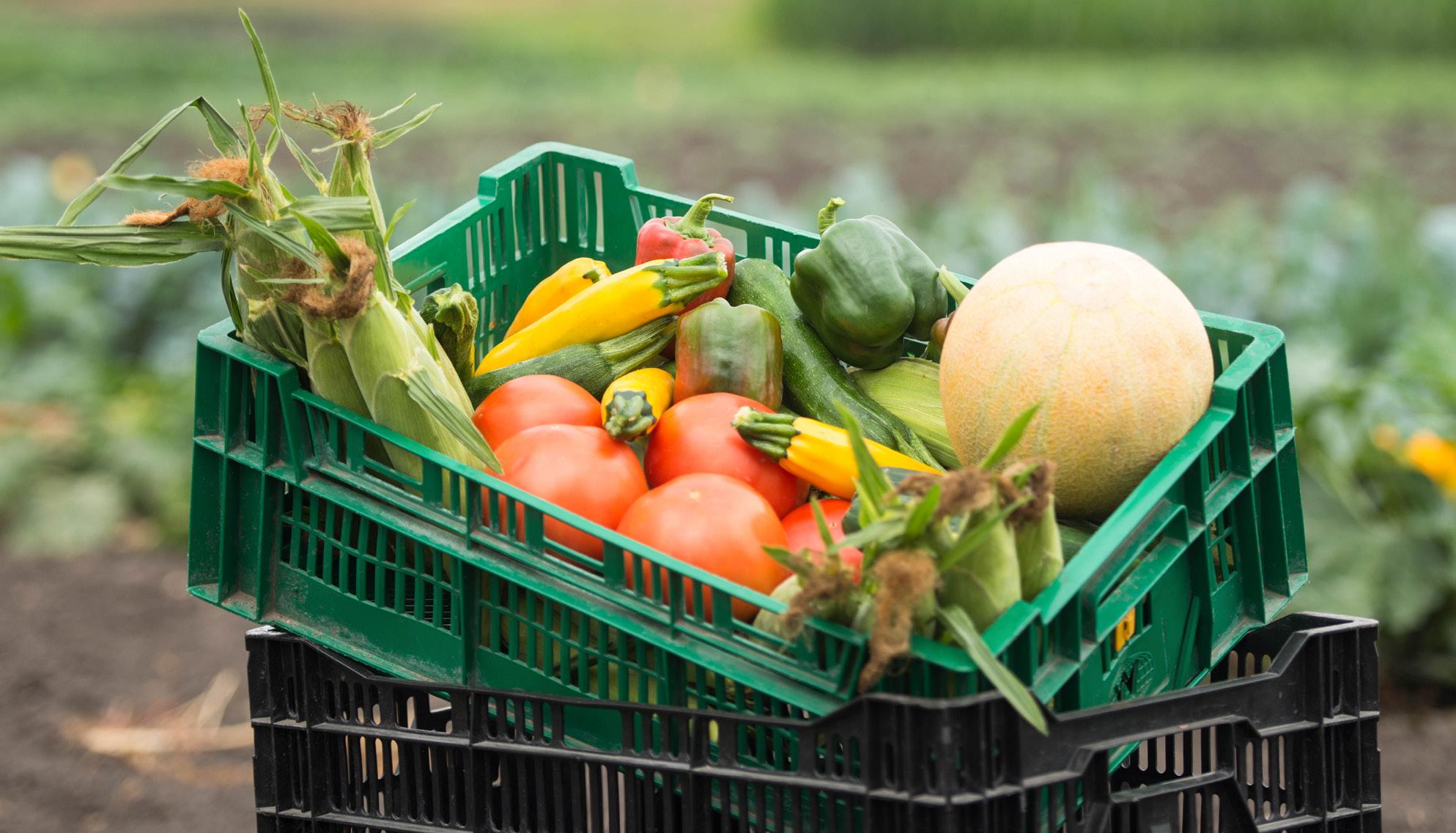
JOIN THE NETWORK OF IOWA FOOD & FAMILY PROJECT PARTNERS IN CELEBRATING THE BEST OF FOOD, FARMING AND HEALTHY LIVING AT THESE COMMUNITY EVENTS.
Nothing compares to the iconic combination of food, farming and community that make up the internationally acclaimed Iowa State Fair.
Don’t miss the fabulous fair food served up by our friends at the Iowa Pork Tent, Cattlemen’s Beef Quarters, Iowa Turkey Grill, The Dairy Barn and Egg on a Stick!
iowastatefair.org
E VENTS AT THE IOWA STATE FAIR:
I OWA FOOD & FAMILY PROJECT EXHIBIT
Varied Industries Building
AUGUST 8-18
Farming is Iowa’s masterpiece! Stop by the Iowa Food & Family Project display in the south atrium to be a part of the creativity, collaboration and color of agriculture.
iowafoodandfamily.com/event
KID FIND WRISTBANDS
Outside the Grandstand
AUGUST 8-18
iowastatefair.org/safety
GOVERNOR’S CHARITY STEER SHOW
Pioneer Livestock Pavilion
AUGUST 10
iabeef.org

SOY SALAD DRESSING CONTEST
Agriculture Building
AUGUST 12
restaurantiowa.com
FARM TO FAIR LUNCH
Pioneer Livestock Pavilion
AUGUST 16
iowastatefair.org
IOWA CORN DAY
Grand Concourse
AUGUST 16
iowacorn.org
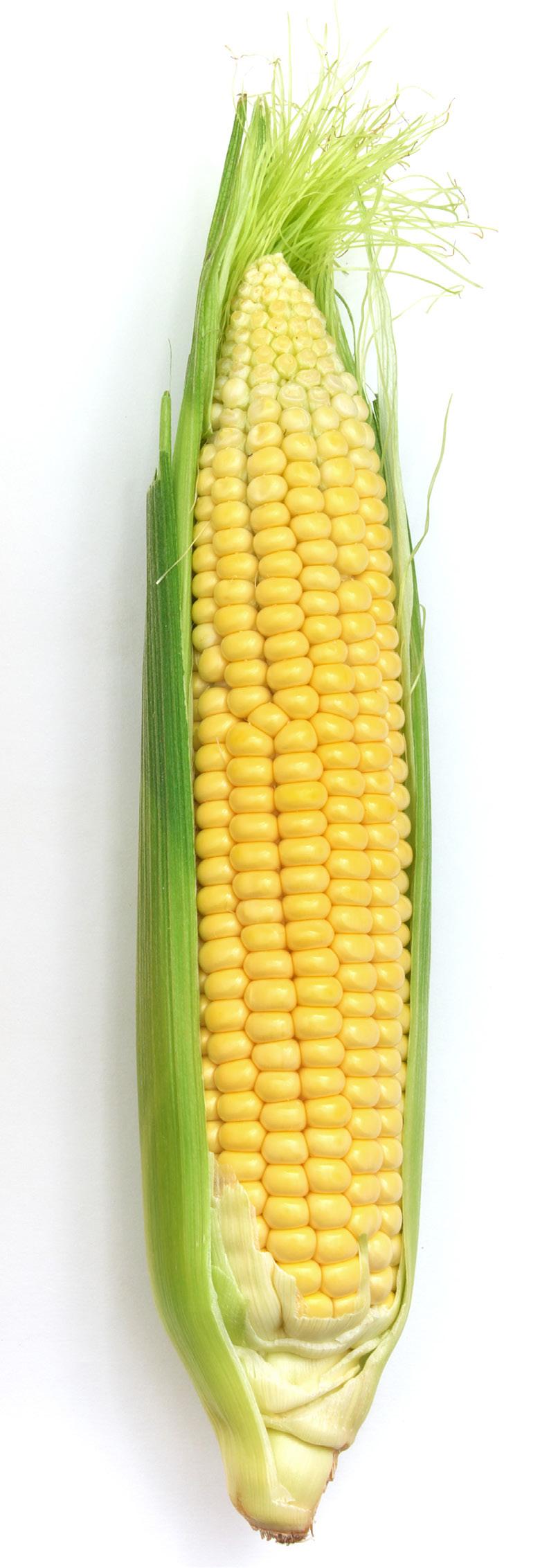
JULY 21-27
Bikers can enjoy free and fresh sweet corn at various stops along the 500-mile route, courtesy of Iowa Corn.
JULY 23
RAGBRAI riders can stop at the Iowa Ag Oasis at Howell’s Greenhouse & Pumpkin Patch to meet farmers and fuel up with protein-packed snacks courtesy of Iowa Soybean Association and Iowa Pork Producers Association.
RAGBRAI.com
AUGUST 23 & 24
See where forks and farming meet during this two-day expedition through northwest Iowa farm country, hosted by the Iowa Food & Family Project. Apply for your chance to attend at iowafoodandfamily.com/ programs/expedition.
SEPTEMBER 7 & 8
Don’t miss the International Chili Society’s three-day world chili competition and outdoor festival at The District at Prairie Trail in Ankeny. chilicookoff.com
SEPTEMBER 14
No matter if you cheer for the Cyclones or Hawkeyes, we all can celebrate the passion of Iowa farmers. Enjoy the in-state rivalry sponsored by Iowa Corn.
SEPTEMBER 9–OCTOBER 18
Get motivated to get moving with the six-week step challenge hosted by Live Healthy Iowa.
livehealthyiowa.org/step-challenge
WHAT ARE YOUR FAVORITE ALL-IOWA FESTIVALS AND COMMUNITY EVENTS? TELL US AT iowafoodandfamily.com/magazine/events FOR YOUR CHANCE TO WIN AN IOWA FOOD & FAMILY PROJECT T-SHIRT.
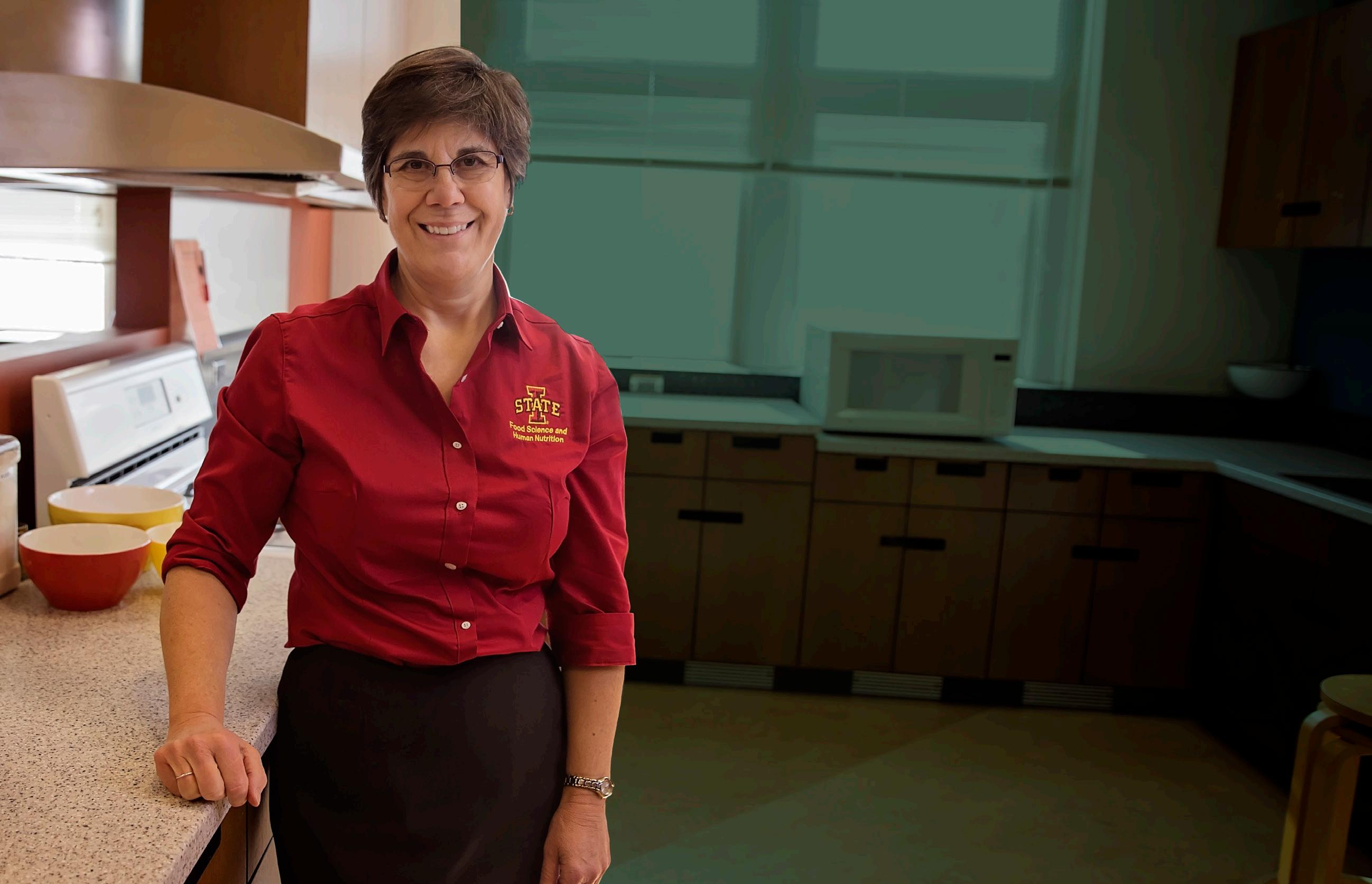 Dr. Ruth MacDonald Professor and Chair Food Science and Human Nutrition Iowa State University
Dr. Ruth MacDonald Professor and Chair Food Science and Human Nutrition Iowa State University
For the answer, we asked Dr. Ruth MacDonald, a respected leader in nutrition and food science, what she wants consumers to understand about the safety of genetically modified foods.
GMOs are safe.
We’ve consumed foods from genetically modified crops for years and there’s no evidence of any risk to human health.
We enjoy the safest food supply in the world. There are no health risks.
The World Health Organization, American Pediatric Association, National Academy of Medicine and others have analyzed thousands of studies and concluded that GMOs are safe.
Genetic modification has been used for decades and GMO crops are the most tested in the history of agriculture. There is no evidence of risk to people, animals or the environment.
As a farmer and a mom, I only feed my family foods that I trust to be safe. Not only are GMOs safe for my family and yours, but GMO technology is better for our environment because it allows us to use less pesticides on our crops. That’s good for everyone. – Sara Ross, Minden, Iowa
